Site Menu:
| This is an archived Horseadvice.com Discussion. The parent article and menus are available on the navigation menu below: |
| HorseAdvice.com » Diseases of Horses » Lameness » Diseases of the Lower Limb » Overview of Fetlock (Ankle) Lameness » |
| Discussion on Breaking Down II | |
| Author | Message |
| Member: sunny66 |
Posted on Saturday, Feb 13, 2010 - 4:45 pm: Here are some conformation pictures: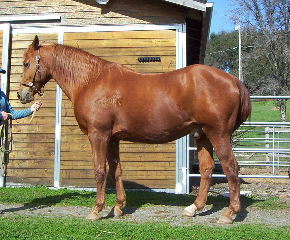 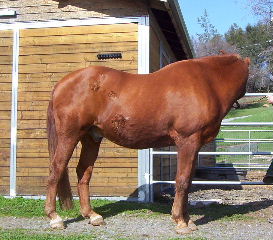 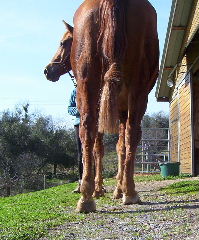 I may be seeing things, but I think he's now losing muscling in his hind end. However, he just rolled, got right up, bucked and cantered off lame about 25 feet... but he then did a full body shake, rarely does that anymore. So pain meds are definitely a good thing here. I only had an assistant for a short time, will try to get more pictures for you today. |
| Member: sunny66 |
Posted on Saturday, Feb 13, 2010 - 5:18 pm: Here's some more: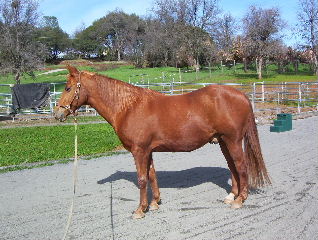  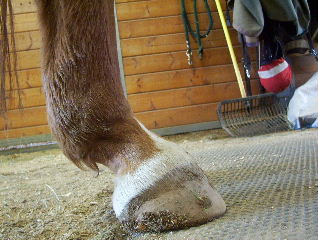
|
| Member: scooter |
Posted on Saturday, Feb 13, 2010 - 5:46 pm: Aileen his hooves and fetlocks DO look much better in these pics. The hairline does DrOp off quite a bit at his heels, especially the left. It's a long process getting the heels back where they belong, I know as well as anyone. . . I wonder if he digs his toes in because his heels hurt? His fetlocks really don't look too bad in these photos. Flash used to stand with her toes dug into the bedding too. He is still looks a little porky  I just got the weight tape out today and weighed Hank, suprisingly the little piglet isn't too bad for this time of year. I just got the weight tape out today and weighed Hank, suprisingly the little piglet isn't too bad for this time of year. Hope with the new pics you can get some opinions |
| Member: sunny66 |
Posted on Saturday, Feb 13, 2010 - 7:02 pm: Thank you Diane, yes, still a little porky, but I can still feel ribs! He has no fat behind his shoulders, nor his hind end.I honestly don't know. I see bruising at the quarter in the left hind, I wonder if that could be a cause, but the way he stands when I pick his feet... I really think it's farther up. He's going down quite a bit at the walk now. Too much flexion in the pasterns. |
| Member: sunny66 |
Posted on Saturday, Feb 27, 2010 - 7:17 pm: Update...He's a bit stronger, not as lax when in motion as he was the last time I posted, still goes down just not as scary. Not certain if he's better, I don't know if he's shedding so it seems like his pasterns are longer or what...Fully weight baring 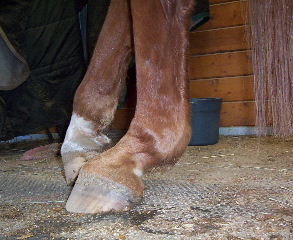 Standing even 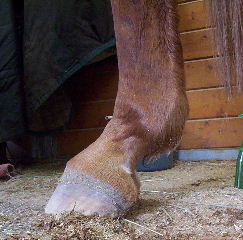 Both hinds 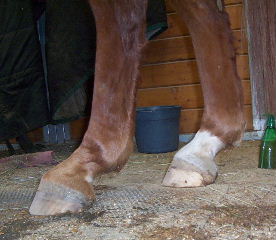 I'm wrapping him at night in regular standing wraps on all four. I know he'll never get really better; but does he look improved at all or am I just hoping? |
| Member: scooter |
Posted on Saturday, Feb 27, 2010 - 11:43 pm: Aileen I was wondering how Brave was doing.. I think of him when doing hoof threads His fetlocks don't look bad  but if he has DSLD can they go from bad to better?? I don't remember if you found out if he had DSLD for sure? but if he has DSLD can they go from bad to better?? I don't remember if you found out if he had DSLD for sure?
|
| Member: sunny66 |
Posted on Sunday, Feb 28, 2010 - 9:28 am: Thank you Diane, no we will not know if he has it until necropsy. I heard that horses with dsld can improve and then get worse.... Dr. O?He's getting trimmed on the 3rd. Will most likely do what she did last time, just bring back the heels clean up the bars, and bevel the hooves. I think he's improving, has more concavity, and the heels - while not perfect - have not gotten worse at least. His front feet have more concavity now that he's sloughed off his sole, they had thrush in the soles! He's down to live sole now. I hope nothing else is brewing in there. I was able to clean most of it out with a hoof pick. He had been moving like an old man for about a week even on pain meds daily, stopped moving like that last Thursday. Chiro vet came out and gave him accupuncture treatment. She said he's very reactive to his right stifle and left hock and that doesn't help the breaking down. I really think the reason for the old man walking was because he was out in the pelvic area. He's on equioxx every other day and feeling fine. Gets up fine but still is a bit lame for about 30 seconds, reared on me in hand yesterday... lol ... cracked me up. I read your threads but I just don't know what to say most of the time, but know I think of you! |
| Member: scooter |
Posted on Monday, Mar 1, 2010 - 6:39 am: I hope he continues to improve Aileen, getting his hooves in order can do nothing but help him. It is a slow process tho. It's amazing how right before our eyes their hooves get so out of whack and seems to take years to fix He sure is spoiled, he gets better medical treatment then me  Keep us updated I think of Brave often. |
| Member: sunny66 |
Posted on Monday, Mar 1, 2010 - 3:53 pm: Thank you Diane, he is spoiled he gets better treatment than I do too! he gets better treatment than I do too! I talked with *the* lameness vet around here and this is what he said: He said that since this disease does not have anything concrete to base a diagnosis, he ok'd the following: Previcox each or every other day Turnout during the day and stall/run at night - I did question this further as to whether the increased movement in the pasture could tear him more but we went with this compromise because he needs to have some sort of quality of life. Watch the spring grass coming in - this will be most important as if he gets too heavy it will cause him to get worse rapidly. Wrapping at night Riding ok when he feels good - only at the walk in the arena slowly working up to 30 minutes. This is also ok'd by his vet and chiro/vet. He needs to move to keep his weight down, which works at just a walk. If he falters at all, give him 3 days off. He did suggest steel shoes behind (no pads or trailers, but good support), but with the pain he is in when taking the shoes off the vet said that is something that I will need to evaluate. If he is ok barefoot, leave him barefoot. We will treat the symptoms as they come, but for right now he is a comfortable, happy, silly, goofy guy. |
| Moderator: DrO |
Posted on Monday, Mar 1, 2010 - 6:37 pm: Aileen,DSLD is a progressive degeneration, the pathology does not improve and then worsen. However the lameness the horse feels is variable and the horse will have good days and bad days. As degeneration worsens there are fewer good days. DrO |
| Member: sunny66 |
Posted on Monday, Mar 1, 2010 - 7:05 pm: Thank you Dr. O,He's stronger again in the pasterns, Dr. O. But I think the improvement I see is in the hoof holding up the leg better. Do let me know if you do not agree with what I wrote previously and he should be confined. Thanks Dr. O. |
| Member: scooter |
Posted on Monday, Mar 1, 2010 - 7:20 pm: Aileen why do you think he may need to be confined? |
| Member: rtrotter |
Posted on Monday, Mar 1, 2010 - 8:31 pm: Aileen,I've been reading this discussion, so I thought I'd chime in. First, when you do up his legs are you using anything on them? Are you using back on track no-bow bandages ( the black ones) or are you using regular standing wraps and bandages? Second, there is a preparation that I use when I have a suspensory or tendon problem with one of my race horses. It used to be called Shin-Ban, but I think they changed the name to S-B solution. It's a rather mild leg paint and does a good job of tightening tendons and ligaments. I do not have a bottle in front of me to give you the ingredients, but I think Big Dee's carries it www.bigdweb.com. It can be used with or without bandages, you can cold water hose with it. I paint (very soft-bristle paint brush, looks like a toothbrush) for 3 days and then sweat for three days, so as to avoid any build up or too much of a reaction. Using it like this first brings a little more circulation to whatever area you are painting and the sweat (I use Fura-free) gets rid of the extra fluid and tightens down the leg. I've always had good results with it. The reason I asked about what type of bandages is I would not use anything under the Black Back On Track bandages you might get too much of a reaction. As far as his feet go, they do look better and he seems to be standing better in this last set of pictures. I will be curious to see him after he gets trimmed this time. Rachelle |
| Member: sunny66 |
Posted on Tuesday, Mar 2, 2010 - 11:12 am: Hi Diane,I don't want to make another mistake because losing him because of my mistake would cause me great heartache. Since there is no definitive test for what he may have, could it be that if he improves, could that mean he doesn't have it? If he doesn't have it would confinement be better for him right now? It's a gamble. What should I place my bet on? I have three professionals (two very well-respected) telling me not to confine him and ride him keeping his issues in mind and not to overtax him. I know someone who is not a vet but a trainer/horsewoman for years that states I should confine him to let him heal. She just lost her beloved horse to this and it was a tragic ending to say the least. I do not want this for my boy. That said, I'm going with the professionals at this time unless I hear overwelming reasons why I should not. Don't you love how decisive I am! I'll be better next week :: wink:: Rachelle, Thanks so much! I will look into the solution. I do have Back on Track bandages for him. They caused him to be MORE lax behind when used overnight after a few weeks. I now use regular no bows and they seem to be working well, so far at least. He hasn't tried to take them off! I have used the sore no more poultice on him, but usually in the summer since it's difficult to get off in the winter. Thank you for your input on his feet, I will update with pictures on Saturday. |
| Member: scooter |
Posted on Tuesday, Mar 2, 2010 - 4:29 pm: I see your dilemma . What is it the trainer/horsewoman thinks Brave may have that confinement will fix? . What is it the trainer/horsewoman thinks Brave may have that confinement will fix? MOST Anything I have read about DSLD suggests 24/7 turnout. If you continue to get the weight off him  and get those hooves fixed You will be doing a lot to help him DSLD or not. and get those hooves fixed You will be doing a lot to help him DSLD or not. I hope he continues to improve which would suggest DSLD is not the problem 
|
| Member: sunny66 |
Posted on Tuesday, Mar 2, 2010 - 5:09 pm: I hope so too Diane, then at least I can keep him where he's at.I too have read 24/7 turnout in many places. The AAEP had a video up saying 30 minutes of exercise is good for horses with dsld. She thinks he has issues behind that are not holding him up... ie, dsld. I will admit having guilt that if I would have locked him in when I first noticed this in 2009, he might be better off today; if I would have kept pestering the farrier, he may be better off today; and so on and so on. re: weight... yes I know. I'm tempted to try thyroid meds, but I just can't get over the fact that it was when I tried them four years ago that this all started. He went crazy with rodeoing just about all the time. When I was able to ride him at a walk he did lose weight, I'm hoping he'll stay in good enough condition that I can get him to lose weight that way starting in a couple of weeks. I took his hay down to 7 pounds (meadow) total today, just for a week. He's off pasture, I can still feel ribs and he's not filling in with fat but he's on the verge so I want to nip it. My poor horse. |
| Member: scooter |
Posted on Tuesday, Mar 2, 2010 - 5:40 pm: Aileen that is a 2 way road..he may have gotten worse too. There is no way to know, we do what we think is best and that is all we can do. Look at poor Hank . I foundered him letting him get too fat, I didn't know enough about hooves to help him ( and didn't want too . I foundered him letting him get too fat, I didn't know enough about hooves to help him ( and didn't want too )and actually made him worse.) )and actually made him worse.) He is on a strict diet for the most part...except when it is extremely cold, like Brave he breathes and gains #50's. His hooves, well I am now learning thanks to HA, and actually kind of like doing Hanks hooves, the "professionals" have trashed them. We live and learn, it's all very frustrating and you feel helpless. UNTIL you arm yourself with knowledge and hopefully fix all the mistakes you make along the way. Horses are tougher creatures then we give them credit for and have amazing healing powers...and are very forgiving  I hope Brave turns out like Flash did, I am not exaggerating when I say her fetlocks looked worse than Braves in his pictures. Her hooves were very similar.. the farrier before this one did that. She switched weight... dug holes... and just was down right uncomfortable. She still has her problems but nothing near as bad as she was..after all she is pushing 31, and doing very well. Out 24/7 with the boys and keeping right up with them, the last time she had a nasid was because she bowed her tendon...when she looked like Brave she got them daily and they really didn't seem to help much. So maybe Brave can turn out as well as Flash...I really thought she had DSLD or ESPM or hip arthritis...it was mostly her hooves and fat 
|
| Member: rtrotter |
Posted on Tuesday, Mar 2, 2010 - 6:22 pm: Aileen,When you say lax, can you describe what you mean. I have had very good luck with the Back on track bandages. But, they are tricky to use in the beginning. You almost have to use them like ice packs where you would take them off after an hour or so. Then each day you put them on for longer and longer until you can leave them on over night. The idea with them is basically the same as the paint, it brings circulation to the area and that might cause some reaction. If you tried say one day on and two days off, or maybe every other day. You might have better results. I also agree with Diane that if his feet can get straightened out, some of his conformation problems may get reduced.And straightening out his feet will definitely make him feel better. Rachelle |
| Moderator: DrO |
Posted on Wednesday, Mar 3, 2010 - 7:06 am: I would not confine a DSLD horse to the stall for the reason you give: a better quality of life.DrO |
| Member: sunny66 |
Posted on Wednesday, Mar 3, 2010 - 10:57 am: Thank you Dr. O, I truly appreciate your input and trust that you will set me straight if you see me going down the wrong track here. Thank you very much.Thank you too Diane, you made me feel a bit better  But only time will tell. I just hope I can keep him the way he is for a very long time - well minus the fat lol. But only time will tell. I just hope I can keep him the way he is for a very long time - well minus the fat lol. Rachelle, I did the introduction to the BOT bandages. I didn't have this lax reaction until weeks after I started them. I can put them on for 4 hours at a time without the reaction and I did that on the weekends, during the week I'd put them on for a 2-3 hours at night and they worked well. When I say lax, I mean his pasterns are more flexible, go down farther when in motion. He'll go lax in just one 12 hour period - perhaps too much circulation? The front legs do very well in them. Using just the regular standing wraps for the hinds he seems stronger behind. I'll try for a short video this weekend too. Thank you too very much Rachelle. |
| Member: sunny66 |
Posted on Sunday, Mar 7, 2010 - 2:10 pm: I would have posted these yesterday but we had to put down a 37 year old gelding He's been not good. Getting worse even on pain meds daily. Today I took him the arena and he would not walk out. I put boots on the front feet and he did walk out, even trotted - I didn't ask! I took the boots back off and tried again thinking it may have been arthritis and he wouldn't walk again. I'm thinking of putting front shoes on tomorrow. I think he's compensating too much. That said, he did canter a few steps yesterday in pasture. Ack. What to do? His front heels have improved - they were folding under as the hind heels were. He's not were I want him for sure, but better. She trimmed him on March 3, was conservative and he's still sore. I'm keeping him bare behind though. Left hind: 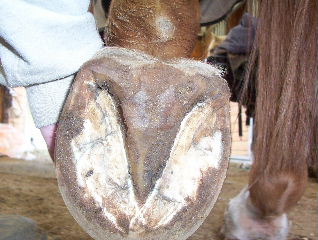 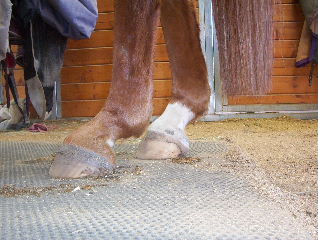 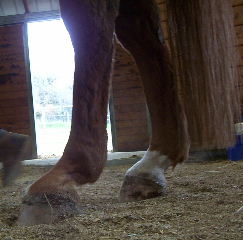 I couldn't get him to stand square behind and I'm certain it's because the front feet hurt. Right hind: 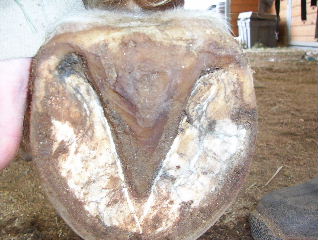 Right Front, he's more ouchy on this foot: 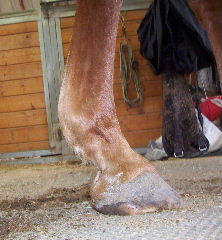 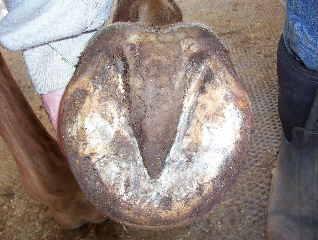 Left Front: 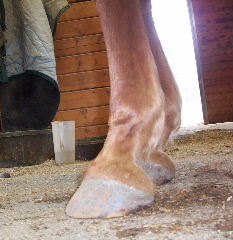 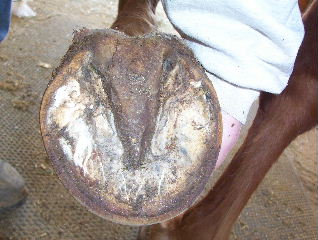 I think if she puts shoes on him she'll be able to balance his foot better. She's afraid to do too much and I don't blame her. She's at a loss with him. I think she's done a good job on the hind feet. I'd just keep him in boots, but he's had thrush issues so I can't keep them on all the time. With his hind end the way it is I don't think it's a good idea to not have some sort of support for him. Agree? Disagree? Thanks! |
| Member: rtrotter |
Posted on Sunday, Mar 7, 2010 - 2:53 pm: Aileen,Just my two cents, I think you need to give barefoot a little bit more time. I can see an improvement just in the way this horse is standing, he almost looks normal at least from these pictures and in comparison to what you began with. Sometimes 4 days is not enough to get the foot to remodel and he still looks like he has some issues that need to be worked on. Time is what you need here not shoes and I'd like to see a bit more bevel around the entire foot. Rachelle |
| Member: sunny66 |
Posted on Sunday, Mar 7, 2010 - 3:13 pm: Thank you Rachelle, my first thought was to give him a week before deciding, but the difference in bare and boots was significant. I want to be clear that I'm not shoeing him behind. He can't handle it and I think he's improved leaps and bounds behind.Doesn't the front take most of the weight of the horse? I don't want him shifting his weight to the hind end. |
| Member: rtrotter |
Posted on Sunday, Mar 7, 2010 - 3:42 pm: Aileen,If you could continue in boots and deal with the thrush issues( Like pack the thrush with Tomorrow and put his boots on) or would it be possible to only have him in boots some of the time. It has been my experience that horses will tell you what they want to do and many problems arise because we insist they do what we want them to do. If, there is someplace that you could leave him be 24/7 mostly without the boots, I think he'd get it sorted out himself as to how much he can and can't do. Even if it's just a small area, I always think that unless its a broken bone, horses are much better moving around. Also as his feet get better, the laxness in his suspensories may go away but it the sort of thing where you won't know from one day to the next if his feet hurt or his suspensories hurt, but eventually things will calm down. And you can call me crazy, but I am not an advocate of long term pain treatment because it sometimes disguises things that shouldn't be hidden. This though is a decision between you and your vet. Rachelle Just my two cents. |
| Member: scooter |
Posted on Sunday, Mar 7, 2010 - 3:59 pm: Aileen I SOOOO know what you are going thru! YES being sore in the front throws the back way out of wack! I saw that with Hank just recently when the farrier trimmed him, his back almost looked worse then his fronts!!How is he on soft ground?? You know I have been back and forth with shoes for years...with barefoot being the goal eventually (Hank has way more pathologies in front then Brave) I was worried he was going to bruise his CB and then get pedal osteitis....who know he may have that now too! I don't know if you have been following Vickis Divas transition but that is about what you need to do. Use the boots for turnout and take them off when he is in. His fronts are coming along from your post from long ago, as Rachelle said give it a little time. Thrushbuster applied once a week to Hanks soles are really helping to harden them. I like to give it 2 weeks. If he is on Nasids don't put him on hard ground until you can handwalk him comfortably on it....without Nasids. NOW someone help me here but wouldn't rockering (strong bevel) his toe help out a bunch?? Hanks heel is getting much less under run doing this or am I off base. Aileen I want to show you the difference since Hanks been barefoot in his UR heel. Just from me beveling it from Dec. every week.. He was sound until the farrier hacked off his hooves  This is the day he got his shoes pulled...looks kind of similar to Braves. Notice the hairline and how UR his heels are. Sept 6 2009 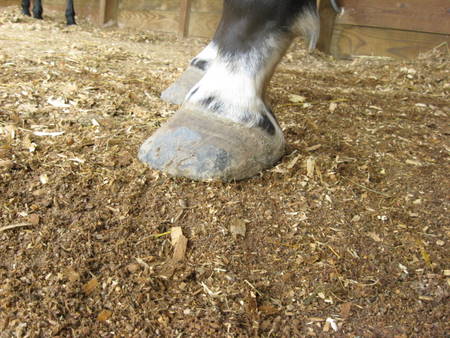 Yesterday...far from perfect, but notice his hairline and how his heel is coming back. We weren't getting that done with shoes. 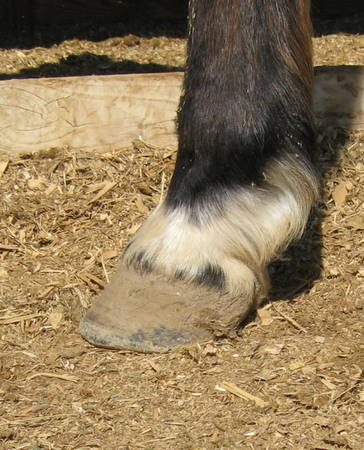
|
| Member: sunny66 |
Posted on Sunday, Mar 7, 2010 - 4:19 pm: Hi Rachelle, totally hear you about the pain meds. However, three vets said he needs to be on them. I have to admit his fetlocks look MUCH better on pain meds than without. I do think they are helping him. The biggest reason he is on them is so he can get up from laying down. If not on pain meds it's hard for him to get up and get his hind legs under him. It's absolutely heartbreaking to watch.I was a big advocate of barefoot with no pain meds so he wouldn't bruise his feet, but it cannot be right now. It would be cruel for him not to be able to get up without a simple pill. I did question the vet because it was advised when he was sound walk/trot and canter.... just couldn't get up. I just came from checking his feet, I left the boots on, he was very sweaty and it's only 68 degrees here. I just think that would compound things. I will admit to leaning heavily toward shoes on front and you've inadvertently made an argument for it. I don't want him to bruise his feet. The ground will be hardening significantly now. Little to no rain in the forecast. Diane, his feet look much better! You've done a fabulous job   I agree with both of you that barefoot fixes hooves quicker, I know. Been there done that with fixing his navicular. But he wasn't breaking down behind then and I didn't have to give him pain meds just so he can get up. I agree with both of you that barefoot fixes hooves quicker, I know. Been there done that with fixing his navicular. But he wasn't breaking down behind then and I didn't have to give him pain meds just so he can get up. 
|
| Member: scooter |
Posted on Sunday, Mar 7, 2010 - 5:25 pm: Aileen it is your choice of course.. I will say Flash couldn't get up well either when her fetlocks/hooves were like that. It is heartbreaking, and I really wondered if her "time" wasn't near.I still can't hold her back legs up, but that's ok, that is her only "real" problem. She is getting up and down fine now. The thing is if it is possible that his hooves are a good part of his problem I would try to get them fixed... Brave may be sore with shoes on the front also...Hank was...just not quite as noticeable. The shoes Could be actually be hindering his hindend because his hooves hurt. Hank lost his canter when he was in shoes, it felt like his back legs had something wrong with them. Once his front hooves got straightened out, so did his back end, his canter came back and still is getting better...just something to think about. I wanted to show you the difference in Hanks hoof to maybe encourage you, it only took From Dec. until now for that much difference..3 mos.of beveling and I really don't have much of an idea of what I'm doing! It is much more labor intense with the boots ect, and turning your head when they look sore...they do get over it. I would give him 2 weeks and see what happens. He does have a decent hoof in there, wish I knew enough to help you. I do think rockering his toe would be of help...  but I only know enough to be dangerous which is alright with my horses hooves but I only know enough to be dangerous which is alright with my horses hooves
|
| Member: sunny66 |
Posted on Sunday, Mar 7, 2010 - 7:10 pm: I hear you Diane, loud and clear. I had two friends look at him just now. He has bruising on his hind heels. I really do think he is compensating by putting too much weight on the hind feet since his front feet are sore. I really feel this is detrimental to his fetlocks breaking down.What about softride boots? Do they discourage bacteria? Do any boots discourage bacteria growth? |
| Member: scooter |
Posted on Sunday, Mar 7, 2010 - 7:29 pm: None that I know of, I had the best luck with the Davis Barrier boot with little swimmers applied to the hoof with gold bond sprinkled on them.. his hoof stayed very dry and the Barrier boots aren't real expensive (CAN'T RIDE IN THEM) Would the equicasts be a solution for you?As far as the bruising on his hind heels, that could just be from the trim (old bruising) just showing up...rarely do they show bruising that quickly. It is possible the bruising you are seeing now in the hinds is the reason he was so sore back there before. You just have to sort it all out.. If you think he needs shoes you should put them on, nobody knows better than the owner ( UsuallY  ) )
|
| Member: sunny66 |
Posted on Sunday, Mar 7, 2010 - 9:51 pm: You make sense Diane, I want you to know that since it doesn't appear that I'm getting that across. He WAS sore for two weeks after shoeing his front feet only. The soft ride boots say they can stay on 24/7, but taking them off once a day and cleaning the hoof. They appear to be lighter than his cavallo simples.The simples are just so heavy and hard and rub him. They are very closed up and no air can get in, especially since I have to use gators with them. He's just uncomfortable in them, he was in his stall when I took them off. Once I did he walked out, albight very gingerly. The soft rides appear to be more forgiving. If I can figure something out to give him relief for two weeks at a time, without bringing his horrible thrush back (that we just got semi cleared up), that would be the ideal thing. I think I'll go with Rachelle's suggestion of packing tomorrow in his feet and use the soft rides. Will order them tomorrow. Thanks very much to both you and Rachelle! |
| Member: scooter |
Posted on Sunday, Mar 7, 2010 - 10:19 pm: I hope it works for you Aileen. I know Vicki Z.'s Perry got sore heels and some thrush from the soft rides, but he was in them for quite some time. I got Sam the easyboot RX's they are much cheaper. Easy to put on. He had no problem with them being on about 10 hrs. a day...they do have some ventilation and I believe are quite similar to the soft rides, except maybe a little sturdier for turn out. You may want to look into them also. I think the gel pad would be less likely to cause thrush than the closed foam ones. JMHO.Good Luck |
| Member: vickiann |
Posted on Sunday, Mar 7, 2010 - 11:57 pm: Aileen,Perry got very sore heels from the Soft Rides that I ordered that were too large but he did not get sore in those belonging to my Vet. Measure carefully and they suggest fitting them snugly. My Vet has had clients whose horses were in the Soft Rides for several (6, I think) months. He said to take them off to clean out shavings at least every other day but after the first week or two I began doing it at least daily. They are easy to get on and off. I tried to use Cavallos on Lance for riding in the mountains and he got very sore. His heel bulbs looked like they were literally burned. It seemed almost like a reaction to the fabric. |
| Member: sunny66 |
Posted on Monday, Mar 8, 2010 - 10:38 am: I looked up the easyboot rx. The fact that they have ventilation is huge. I will order for his front feet. His hind feet are smaller than his fronts, but I should get a good idea if the wrap around his fetlocks would work for his hind feet as well. If not, I'll get the soft rides for his hind feet.He didn't need pads in the cavalos yesterday, I think I can get away without them for now. But what do you think? Thank you very much for saving me money! |
| Member: sunny66 |
Posted on Monday, Mar 8, 2010 - 10:41 am: Vicki, thank you, that's exactly what I think is happening with the cavalos. Thanks for the input on the softrides. I'll figure this out yet!Ok, off to order. Thanks again! |
| Member: vickiann |
Posted on Monday, Mar 8, 2010 - 12:21 pm: Did you ever see the Internet photos of people who had what looked like burns on their feet from the flip flops made in China?https://www.snopes.com/medical/toxins/flipflop.asp What happened to Lance's heel bulbs from the Cavallos (the ones I bought were made in China) was similar to the worst of the photos that I saw. It was horrible (looked like raw meat) and did NOT appear to be caused by rubbing but more like a chemical burn. It took many weeks for it to clear up. |
| Member: kpaint |
Posted on Monday, Mar 8, 2010 - 12:35 pm: Wow Vicki Z, I'm glad you mentioned the burns since I'm boot shopping. Made in the USA would be best. |
| Member: sunny66 |
Posted on Monday, Mar 8, 2010 - 12:47 pm: Will he get burns from the rxs you think? Should I just cancel and get the softrides? |
| Member: vickiann |
Posted on Monday, Mar 8, 2010 - 2:00 pm: Like everything else, what works for one or many may not work for a particular horse.After my experience with the "made in China" boots, and some other products too, country of origin is a major consideration for me. I always try to buy made in the U.S.A. and if that is not available, a nation with even higher standards. Even with made in the U.S.A., sometimes the components come from places without enough quality control. Buyer beware, I guess. |
| Member: sunny66 |
Posted on Monday, Mar 8, 2010 - 2:33 pm: Thank you Vicki, Could I ask a favor? Would you mind describing the material on the soft rides around the heel and the pastern? From the pictures it looks like it's fairly soft (not stiff like the cavalos) around the pastern, is that a correct assumption?Diane, could you describe the RXs? I'm specifically looking for the stiffness around the pastern. The cavalo's are that way and they cup the back of the hoof. Are the rx's like that all the way up the pastern? I've read the descriptions of both products looked for pictures from behind, but I can't picture the back of these boots. Thank you so much! |
| Member: scooter |
Posted on Monday, Mar 8, 2010 - 3:51 pm: The RX are soft behind, I don't know if you are familiar with Muck boots but the material where their heel bulbs go is very much like the material on top of a muck boot. Sam had no problems with rubs. I took some pics for you so you could see.Nothing above the boot platform is hard. 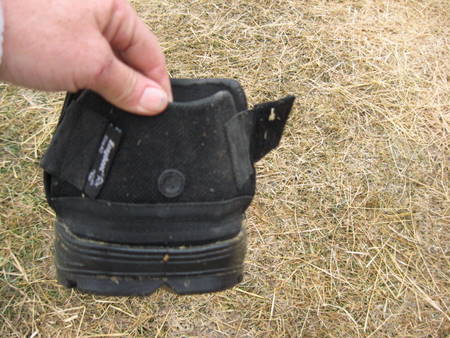 This is where the heel bulbs go 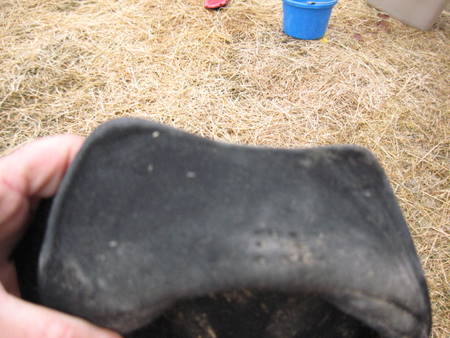 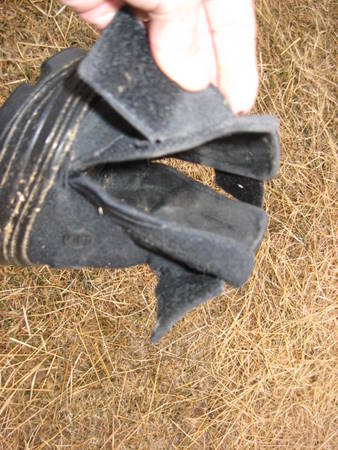 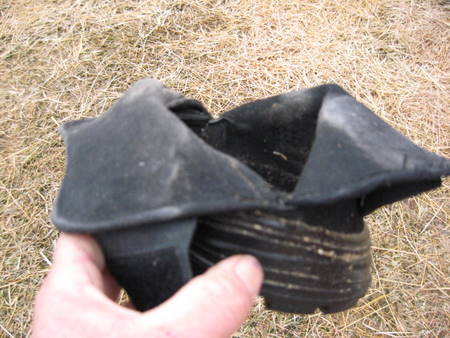
|
| Member: sunny66 |
Posted on Monday, Mar 8, 2010 - 4:10 pm: Thank you so much! I think they'll work. I've ordered the RXs for his front feet and soft rides for his hinds... plus a riders rasp! Do you think the rasp will bevel for me or am I still going to have to learn something else? I am so clumsy with a regular rasp it's not even funny. |
| Member: scooter |
Posted on Monday, Mar 8, 2010 - 5:57 pm: Aileen there a couple reasons I liked starting with the RR. It really is pretty harmless, so no major mistakes can be made. It really gave me a "feel" for what I should do with a regular rasp. I did learn to use quite a bit of pressure when using it, it does a much better job. I then added the travelers rasp, I still love that thing! You do have to be a little more careful with that it takes off just as much as a regular rasp and is SOOOO easy to handle... and cheap!! I have now "graduated" to the big girls rasp, but still am getting a feel for that... I think I like the travelers rasp better...much easier to handle. If you are interested in it I think I have the link in product reviews.IMHO in Braves case, I don't think I would boot him 24/7... If you can bed him deeply when he comes in and leave him barefoot, it will give his hooves time to dry. If booted all the time he will never get use to "real ground" They do have to tough it out a bit  as much as we hate to watch it. Hand walking him on hard ground with the boots will help too...that helped Hank considerably...we went for miles on the paved road. When I got back I would remove his boots and he always moved much better. I don't know if the soft rides would hold up to that...but think the RX's would.... for quite awhile anyway. as much as we hate to watch it. Hand walking him on hard ground with the boots will help too...that helped Hank considerably...we went for miles on the paved road. When I got back I would remove his boots and he always moved much better. I don't know if the soft rides would hold up to that...but think the RX's would.... for quite awhile anyway. Good Luck, keep us up to date. I think Brave is ready. You have been fighting this as long as me! BTW there are very good tutorials from the good folks on here in all of Hanks Critique threads on how to bevel.... starting with the RR will give you a good feel for it |
| Member: sunny66 |
Posted on Monday, Mar 8, 2010 - 6:22 pm: Oh no, not something ELSE! ug. Ok, will read your threads with a more "studious" mind.The boots will only be on during the day and most likely for 2 weeks out of the month. He was walking just fine before she trimmed him. I'm hoping that if I can do a little each week, as you noted above, she won't have to do hardly anything to him. But I will not let him compensate with his hind end. He has five bags of shavings in his stall, I can put a couple more in. Thank goodness he goes outside to do his business. I'll take the rider's rasp to him when it gets here next week. I should be able to work on him then. I called the farrier and left her a message of what the plan is, I think my vet will be ok with it if he stays in boots and doesn't hurt. We are getting a little more rain, thank goodness. |
| Member: scooter |
Posted on Monday, Mar 8, 2010 - 7:57 pm: YES study study study and the more you do the more confused you will get
|
| Member: vickiann |
Posted on Tuesday, Mar 9, 2010 - 10:33 am: Yes, Aileen,The fabric with the Soft Rides does not seem to be a problem and caused no irritation for my horse. I had been very worried about that but had no problems in that regard. Hope this boot combination works out well for you. Let us know how it goes. |
| Member: sunny66 |
Posted on Tuesday, Mar 9, 2010 - 11:19 am: Great thank you Vicki... Diane, you're not helping... lolThe boots will be here tomorrow, which is none too soon. He was very very sore last night  If he had an abscess the boots being put on wouldn't solve that, would it? I wouldn't think so, but thought I'd better ask just in case. If he had an abscess the boots being put on wouldn't solve that, would it? I wouldn't think so, but thought I'd better ask just in case.
|
| Member: vickiann |
Posted on Tuesday, Mar 9, 2010 - 2:13 pm: No, the boots can't fix an abscess but would help to cushion against the pain, and perhaps help to prevent a three-legged-horse way of going. |
| Member: kpaint |
Posted on Tuesday, Mar 9, 2010 - 2:42 pm: www.hoofwraps.comAileen, the above site has some very nice, easy to put on wraps which would be helpful if you are doctoring an abscess. They come with stiff foam pads. My Diva mare prefers the "gel pads" sold separately. Of course. |
| Member: sunny66 |
Posted on Tuesday, Mar 9, 2010 - 2:55 pm: Hi Vicki (s) , I hope I'm not doctoring an abscess, because then it would be in both front feet. , I hope I'm not doctoring an abscess, because then it would be in both front feet. Thanks for the link, I'm sure Brave would prefer the gel pads as well... lol ... . I have some epsom poultice, I'll pack that before I put on his new boots. Can I be tired of this yet? He's really lucky he's so funny and cute! |
| Member: scooter |
Posted on Tuesday, Mar 9, 2010 - 4:50 pm: I have been tired of this for years That's why it was time for a change. I went back and started reading through Hanks Critique threads...Aileen if that don't give you encouragement nothing will That's why it was time for a change. I went back and started reading through Hanks Critique threads...Aileen if that don't give you encouragement nothing will Very good info in there. Notice how I thought Hank had to have shoes for comfort too. It was the way the farriers been trimming him making him sore. I'm going to read back through the rest of them...it even encouraged me seeing the difference in his hoof. I am going to have a Part 12 when we reach our goal of barefoot, sound on hard ground...with a pretty hoof Very good info in there. Notice how I thought Hank had to have shoes for comfort too. It was the way the farriers been trimming him making him sore. I'm going to read back through the rest of them...it even encouraged me seeing the difference in his hoof. I am going to have a Part 12 when we reach our goal of barefoot, sound on hard ground...with a pretty hoof ... and we aren't too far away from that now I don't think ... and we aren't too far away from that now I don't think
|
| Member: paul303 |
Posted on Wednesday, Mar 10, 2010 - 12:24 am: Aileen: Is it just me?, or are his feet really, REALLY flat? I see almost no topography on his sole. The frog looks unformed and missing any real cleft and the commissures look very shallow...almost as if the farrier's sole pareing is attempting to give them definition. I'm having trouble finding where the frog ends and the heels, heel butresses and heel bulbs begin...like the whole back of the foot is smooshed together. The bars look a bit anemic, too. Is it possible that his frogs are sore because they are in too much contact with the ground? I have 3 horses. Out of their 12 feet, 4 feet are shod. Without shoes, the feet splay out...the heels underrun and the foot collapses on one. The other one has had navicular synDrOme since the eighties and needs her front shod accordingly. The anatomy and topography of all their feet( shod and unshod )is well defined.So...are his feet that flat....or is it my eyes that are flat? |
| Member: kpaint |
Posted on Wednesday, Mar 10, 2010 - 7:47 am: Lee, I know very little but I was wondering the same thing. It makes me think his entire digital cushion and frog is crushed/worn down/almost nonexistent. Does the DrOpped fetlock put a lot of extra pressure on that area? I'd like to hear Dr. O's thoughts so I don't go off on an ignorant assumption tangent. |
| Member: scooter |
Posted on Wednesday, Mar 10, 2010 - 8:27 am: I wondered the same thing, but with his heel being so forward wouldn't that make the digital cushion weak? If I recall he has had the long toe under run heel thing going on for a LONG time. Correct me if I'm wrong Aileen . . Don't they look flared at the quarters too? wider on one side? I have read, and I think Angie has stated too that the Collateral grooves indicate sole thickness ( I'm not so sure myself) but Hank has had hardly any CG until recently. Those of you that know more does Brave have a good trim? Or is it hard to tell from the pics? Aileen can you get pictures at the angles like in Hanks thread...if you look at the last part 11  like the pics in the beginning. If possible scrub them too. You may be able to get better opinions then. If they aren't close up enough cropping the hoof out helps. like the pics in the beginning. If possible scrub them too. You may be able to get better opinions then. If they aren't close up enough cropping the hoof out helps.
|
| Member: sunny66 |
Posted on Wednesday, Mar 10, 2010 - 10:33 am: Lee, I'm not sure about most of your questions; but I am sure that his front feet were flat, too flat. He now actually has better concavity. His sole depth (per xrays) is only 13 mm and 15 mm.His hind feet I think are just about perfect. Good concavity, we've backed up his heels. She did have to take some frog at the last trimming, but not as much as she has had to in the past. I need to go back to treating him twice a day. All this to say, that he was walking MUCH better last night, still just a tad tentative. When I picked his feet his right front smelled horrible. I have to wonder if he did have an abscess? Vicki, I'll be curious as to what Dr. O has to say. Diane, I'll try for pics this weekend if I get over this stupid vertigo. He has had it a long time, diagnosed navicular because of it. He hadn't had navicular symptoms in years, but he started to show them again last weekend. He'll still cross over and not hop, but we're on the edge. |
| Member: kpaint |
Posted on Wednesday, Mar 10, 2010 - 1:21 pm: Diane, I don't know about collateral grooves as a guide to sole thickness. Diva has deep grooves...? |
| Member: scooter |
Posted on Wednesday, Mar 10, 2010 - 3:28 pm: I think the CG at the APPEX of the frog is what you go by...MORE Reading Vicki you and will be so confused we won't know which way is up! Vicki you and will be so confused we won't know which way is up! https://www.hoofrehab.com/horses_sole.htm |
| Member: scooter |
Posted on Wednesday, Mar 10, 2010 - 3:51 pm: Dr.O. or hoof gurus what is up with the back of those hooves? Lee is right it looks like he is missing parts and the whole thing is running together without any definitions. I noticed that too, but didn't know what to make of it.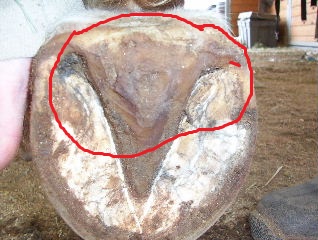
|
| Member: kpaint |
Posted on Wednesday, Mar 10, 2010 - 4:02 pm: Diane, you said it, more reading. I am still at the rudimentary level. |
| Member: paul303 |
Posted on Thursday, Mar 11, 2010 - 1:10 am: I would probably find a reputable shoer and get the pressure off those frogs and heels. You may have a horse that has weak hooves and cannot do without shoes. Is he on any hoof supplements, like Farriers Formula, Horseshoers' Secret.....? You've been trying this barefoot thing for awhile, and it just looks like his foot is collapsing....splaying....losing it's definition.....Brave might need shoes in order to get pressure off the frogs and to control the splaying of the feet. He may not go sound immediately with shoes, but the loss of anatomical landmarks is concerning. Although I favor barefoot, barefoot does not favor every horse or hoof. Brave may have a wonderful trim, but the trim cannot give substance to a weak splaying foot. It may need the support of shoes. I would favor shoes that would roll and rocker the toe to ease Brave's breakover and perhaps a slight extension of the shoe heels...Brave looks long-coupled enough to tolerate that. These are only my impressions, Aileen, I cannot hold his feet in my hands and examine them, but you've done an outstanding job with your photos...and judging from them, this is what I see. I've owned horses since 1970, and I've had hoof concerns since....1970. I've had eight farriers in that time. All but two have been wonderful - embracing all the new techniques and attending ongoing continuing education. They have been free in discussing their impressions of the new theories and how they may apply or not apply to my horses. Don't be afraid to discuss Brave's situation with your farrier. In my experience, the more open you are to acquiring knowledge, the more willing your farrier is to discuss things with you. |
| Moderator: DrO |
Posted on Thursday, Mar 11, 2010 - 7:40 am: I don't see evidence of a crushed frog guys. The frog looks widened but fairly robust in the last image. As to lack of definition, Diane the angles of the bar are pushed outward a bit and the widening of the from has spread and opened the central sulcus. All of this is likely a response to the increased pressure brought on the heels by the DrOpped fetlocks.DrO |
| Member: sunny66 |
Posted on Thursday, Mar 11, 2010 - 10:52 am: Thank you Lee, he's on Smartpak's Ultrahoof, started in November... or January, can't remember. The vet had asked if he was on one and he wasn't. He gave me the amounts of biotin, methionine (sp?) and lysine he needed and the ultrahoof met those recommendations.Whatever you do, when someone tells you to keep their diet simple, don't. Hindsight and all that. He's been barefoot behind since December 2009. He had shoes on behind since last spring. Pads too, which I believe caused the hoof form to deteriorate. My farrier actually asks me what I want done to his feet at each trimming. She IS very open to trying new things, we just haven't heard any new things to try. She is frustrated. Shoes behind: If you saw the pain he is in when taking off the shoes you wouldn't recommend them. Neither do the vets I have talked to and have seen him. Shoes in front however, are a different story. But he was sore for two weeks after being shod for the last 6-7 months I think, maybe longer. He was trimmed on March 3 - conservatively - and he was very sore. Difference this time is that while he was sore, he got soreER after about 3 days. It was last Sat, Sun, Mon and Tuesday that he was the worst. Wednesday he made huge improvements. On March 9 and 10 he was being a goose! He is a feisty soul! Good lord. I think he feels better. lol I got his boots yesterday and will try them on today. To me, it's his front feet that are splayed, not his hind feet. They may be beginning to splay, but from the hind lateral pics and seeing him daily I do not see that on his hind feet. His hoof form has improved/changed and maybe ... just maybe... a couple more months will help. BUT I will check with my farrier if she feels something needs to be done or can be done without shoes. If we could use glueon shoes without yanking on his legs to get them off, I would try that. The barefooters I talk to regularly are not saying he's perfect, but he has greatly improved behind. To me, he looks great - just about perfect - except for the angles when in motion. I've been told you WANT a fat healthy frog. It's only been about a month since he's heels have come back. I'm hoping he just needs a bit more time. Dr O., I would welcome any suggestions you have to his trim. ANYONE: suggestions for the trim would be most welcome. The farrier will be out in a couple of weeks. She wants to fix this horse but is out of ideas. To defend my farrier again, she is called on by vets to fix horses. She's very good. She makes mistakes sometimes, but the fact that she listens and seeks input is priceless to me. She knows I *talk* to trimmers and always asks their recommendations before a trim. They have brought him this far. But even they say the trim can't fix his legs, just help him be more comfy. Question, do we leave the bars alone? Perhaps they know something we don't? Or continue trying to get them where they should be? Slowly and carefully, not extreme. For the front feet beveling that Rachelle stated above, the farrier told me that he would not use the hoof stand, something in his shoulders, so that's why the foot isn't finished I guess. I found out why the shoulders. There is a 7 inch gap between the fence and the gate with a peel core pole in the middle of that gap. He's been pushing over the pole with his shoulders to get grass on the other side of the fence. Gotta love him. |
| Member: scooter |
Posted on Thursday, Mar 11, 2010 - 11:31 am: Aileen I don't have a hoof stand, I do Hanks beveling from the bottom? My farrier rasps from the top with the hoof stand and Hank can't walk for days.The riders rasp will help you see I think. |
| Member: sunny66 |
Posted on Thursday, Mar 11, 2010 - 11:58 am: Really? Ok, I'll tell her. The rasp is coming next week.He had to help put his boots on. I couldn't get them on at first so I put the soft rides on the front... they both fit... oops... so that means they are too big for the back. Anyway, I walked him around in the softrides and man are they heavy! He was clunking around. So I came back and tried the rx's again. I had him pick up his foot and put it back down quite a few times... but they're on and I think they'll do well! Hopefully they aren't too tight. I'm off to the doctor, I'll check him when I get home. Thank you for the rasping from the bottom, that may just be the ticket!!! She's never done it from the bottom that I've seen. |
| Member: scooter |
Posted on Thursday, Mar 11, 2010 - 2:35 pm: HMMM I didn't think you could bevel from the top?? Tho my farrier says he does...NO he don't!There is very detailed instructions in one or 2 of Hanks parts on how to bevel. I'm learning a lot re-reading them!! I think I am starting to comprehend it all a little better. Sam had to help me get his boots on too  I wonder if they run a little small, I still had no problems with rubs. Let us know how he is moving in them. I wonder if they run a little small, I still had no problems with rubs. Let us know how he is moving in them.
|
| Member: sunny66 |
Posted on Thursday, Mar 11, 2010 - 5:42 pm: hmmmm...What she does is put the hoof on the stand, then bevel/round the hoof. That's what I meant by the top... but maybe I'm way off.. I'll ask her how she bevels, no, I'll ask her to teach me how and if she says I need a hoofstand, then I'll know and go from there. Does that sound like it would answer the question?So how do you bevel from the bottom? Which thread is it in? He's already tore a boot... it's still on, but really! IlovemyhorseIlovemyhorseIlovemyhorse... no really, I do love him, but my goodness! I took him out in the arena with them on and I'll have to video him for you. He's not going down nearly as much as he was in motion and just standing he looks quite normal! Stands UP! So I think that tamps down speculation that I had about him shifting his weight behind. Now the plan is to ask about the beveling, if it's from the top I'll ask her not to do that but I'll need an alternative for her. |
| Member: rtrotter |
Posted on Thursday, Mar 11, 2010 - 6:39 pm: Aileen,One of the reasons why farriers and trimmers use a hoof stand is that it is easier on their backs. When you are underneath between 8-15 horses everyday it takes a toll. The reason not to bevel from the top is that you cannot see where to stop. Whereas from the bottom you can angle the rasp to stay away from the white line and you can actually take back the toe more(rockering, between the toe pillars at say 11 and 1 oclock) this way without soring up your horse. This in turn, shortens up the foot the right way and moves back the heel points. It does not look like your hoof person is beveling, the outside edges of your horses feet are too sharp. Its ok to take the rasp and round those sharp edges off when finishing off the trim, but there should never be any rasp marks higher than the bottom third of the foot and preferably the bottom 1/4 of the foot. There is a video out there on youtube if you do a search on barefoot trims. Its by the Happy Hoof Gal. it explains why you should not trim from the top and explains how she learned not to do it after, she thought it was the greatest gift to trimming. It actually causes more harm by removing too much of a horses wall and leads to thin walls and bad feet. You might want to find that link and send it to her. Have fun! Rachelle |
| Member: sunny66 |
Posted on Thursday, Mar 11, 2010 - 6:50 pm: Thank you Rachelle, I'll do that I don't have speakers so I won't be able to glean too much from it though. I don't have speakers so I won't be able to glean too much from it though. She has already been asked not to rasp the hoof wall. But sometimes his front feet get so far out there she has to to balance. However, if I get a handle on the riders rasp maybe that won't occur again? After seeing him in pics and video, he's not so much better... I guess wishful thinking is clouding my judgment. |
| Member: scooter |
Posted on Thursday, Mar 11, 2010 - 8:10 pm: Aileen go to Hanks last thread "the farriers trim" you can see how MY farrier "bevels" from the top and the bad results... further down the thread I ran the riders rasp around his hoof...He was so sore I was scared to do anything Running the RR around made me see a bevel would probably help him.... so further down I did bevel.. he WAS much much better after I beveled. Running the RR around made me see a bevel would probably help him.... so further down I did bevel.. he WAS much much better after I beveled. I think you will see improvement in Braves discomfort when you get him comfortable in front. What you saw may not have been wishful thinking but a glean of things to come  You can't cheat in the learning process, study. There are also some good links in Hanks threads. It all makes your head spin...but really in a way it is all so simple... knowledge is your friend. Dr.O's articles are very good also... as you know! You can't cheat in the learning process, study. There are also some good links in Hanks threads. It all makes your head spin...but really in a way it is all so simple... knowledge is your friend. Dr.O's articles are very good also... as you know!
|
| Member: paul303 |
Posted on Friday, Mar 12, 2010 - 1:44 am: Gee, Aileen, I wish I could be of some help. I'm glad to hear the frogs are healthy. I had a horse with weak sloping pasterns that overflexed badly most of his life. I guess what saved him was the fact that he was small ( 14.1 hands )and ( mostly )lightweight for the better part of his life. He WAS shown Hunter for 15 years and did fences up to 3'6". When my horse was around 15, the farrier pointed out that "he sets his own trim", showing me how ( due to the weak conformation in his rear fetlocks and pasterns )he was squaring off his own rear toes. He felt that it was important to take into account the way a horse wears his feet and to trim and shoe accordingly. "Shoe'm the way they go" he used to say, "ya can't shoe good conformation into a horse if it ain't there to begin with". When he was around 32, we had to stop shoeing in the rear because it got to be too much for him to hold his rear legs up. After that, the farrier just pulled the back legs out gently and trimmed the back feet "the way he goes". People always told us we would lose him to arthritis due to his lax pasterns. We lost him at 38, due to 2 lipomas strangulating his intestines. He was sound his entire life and I credit my farriers. This same theory was applied to an old mare I had with a bone spavin. One side of her foot was raised, and the other was lowered. It worked.Will any of this info help Brave? Gosh, Aileen, I don't know...but I know how you love him. I have no doubt that your farriers have watched the way he moves and have tried their best to find the trim that will serve him. Best of luck, Aileen |
| Member: scooter |
Posted on Friday, Mar 12, 2010 - 7:02 am: Lee, your horse that was squaring off his toe, is exactly what we are telling Aileen to do with the bevel (rocker) it will help to move the break over back and hopefully make Brave more comfortable
|
| Member: sunny66 |
Posted on Friday, Mar 12, 2010 - 10:31 am: Well, he literally galloped out of his boots yesterday! Cracked me up. So we'll see what happens.Lee, he does set his own trim in the hind feet. He squares his own toes. Very little needs to be done behind when she comes out aside from addressing the heels. But now that they are back where they belong, I think I'm finding the need to shift focus to the front feet, which he does not self trim. I do hope we can keep him comfy and he lives to 38! Wow!! That does encourage me a bit to know that he was able to work still. I've been told to ride him just at a walk because: 1) dsld horses do well with 30 minutes of cardio; 2) good for his arthritis; and 3) because it makes him so happy to work. He's a different horse when he feels useful, so content and proud. But I'm petrified I'll make him worse. My head is spinning Diane, but my head is still woozy from vertigo... lol... can you bring the pertinent thread back up so I can find it? Thank you! Looking at the pictures of the front feet, it looks like the right front (the one he is most sore on) was trimmed on the stand, the left was not. There is more wall on the left than on the right. |
| Member: scooter |
Posted on Friday, Mar 12, 2010 - 4:33 pm: All of the info is in the hoof critique threads...part one thru 11 "the farriers trim" is part 11. The rest of the parts have very good info in them. They are under horse care, hooves, the 4 point trim..there is a video at the end of the article that is very good by Ric Redden Glad Brave is feeling better! I think beveling him would go a long ways in keeping him that way and getting the heel back. Keep us updated...and don't let him get fat(ter)!!! https://www.horseadvice.com/horse/messages/3/5126.html |
| Moderator: DrO |
Posted on Friday, Mar 12, 2010 - 6:04 pm: Aileen we have made recommendations before on the trim and those recommendations still stand.DrO |
| Member: sunny66 |
Posted on Friday, Mar 12, 2010 - 6:53 pm: Thank you Dr. O. She hasn't been able to do a real trim in months. She's tried doing less and less to see if it doesn't make him sore and it doesn't work.If she doesn't trim him he'll get out of balance. If she does trim him he's sore. She's a very sought after farrier, she fixes horses, yet she does not understand why this horse is always sore. We just can't figure out what it is she's doing to make him sore. I'm going with the rasping the hoof wall and beveling for now, we'll see what happens. Thank you Diane, I read No. 11 and while helpful I didn't see a "how to" on beveling. I'll wait until Monday when I can hear Rachelle's video of it. He's in the softrides right now, standing in his stall and watching the rain. They are sending me a new rx for the one he tore already so that was very nice of them. Time change is Sunday and Spring is coming tomorrow so I'm going to start his exercise program in earnest instead of just on non-rainy days. |
| Member: scooter |
Posted on Friday, Mar 12, 2010 - 11:22 pm: Aileen, Hank was ALWAYS/ IS sore after a trim also.. the reason is in part 11 the farriers trim. It really is hard to tell from your pictures... so this could be way off. It APPEARS that you may be having the same problem. It almost looks like Brave is on his sole at the toe.. IF he is that would explain why he is sore after a trim and better right before he is due for a trim. With shoes he MAY have had sole contact and that is why he was sore with them... this is speculation from one picture.. hold his hoof up and see if his sole is higher than the wall.. It may be better now that it has grown out some.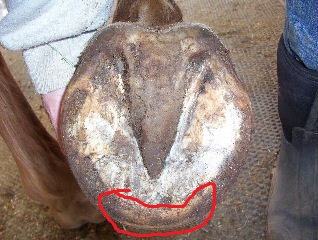
|
| Member: scooter |
Posted on Friday, Mar 12, 2010 - 11:31 pm: Here is the LF Notice he does have more wall at the toe (that a bevel would help) and probably why he isn't as sore on that one... This is FME with Hank and assuming I'm seeing it right from the pics...if that is the way it is...it explains your problem...somewhat...actually quite a bit See the difference. 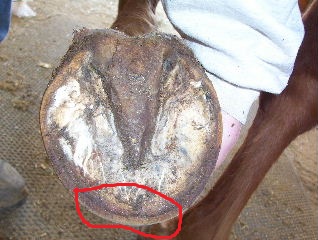
|
| Member: sunny66 |
Posted on Saturday, Mar 13, 2010 - 9:57 am: I think that the whole hoof is supposed to carry the load, not just the wall, not just the sole, not just the heels, but all of the hoof. So you think he's just walking on his soles? hmmm could be! I'm assuming this relates to the rasping from the top so she can't see what she's doing in regard to the sole? I'll be taking pictures today if I'm not too dizzy and I'll try to take one of the sole from the side to see. |
| Member: scooter |
Posted on Saturday, Mar 13, 2010 - 1:47 pm: You are absolutely right, if he is on his sole at the toe he is going to be sore, especially since he is thin soled. It's a little more complicated ( I think) then rasping from the top or the bottom. It took 11 parts to figure out my farrier can not bevel or rocker from the top. But when looking back at all his pictures through out the years this has been the problem.(why he gets sore after a trim)As I am learning the inner wall is suppose to help carry the load (bevel) not the outer wall... which causes the flares... it APPEARS this is the case with Brave... good pictures would help, if you can scrub them first all the better 
|
| Member: sunny66 |
Posted on Wednesday, Mar 31, 2010 - 1:13 pm: Just an update...He got better after the farrier came and took something off his front soles - bar perhaps? I wasn't there. He just improved from there as far as soreness on his front feet as he grew more hoof. So maybe a little of walking on his sole and bar?In ten days he went from ok to bad as far as his fetlocks go. 10 days ago it was spring, today it's winter - we even had a bit of snow. This is from March 21: 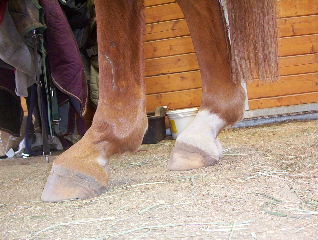 Virtually the same stance today: 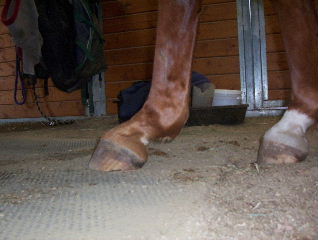 More from today: Left hind: No too bad when evenly weighted 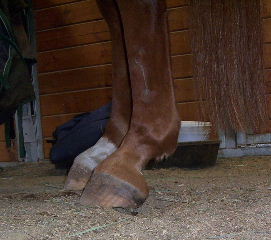 Right hind: 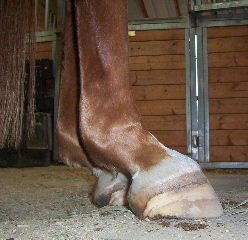 It appears to me though that his right hind is worse now... 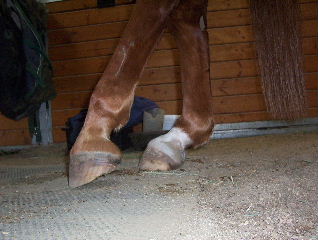 I've noticed that the hoof wall near the heel on the left hind is not as scrunched up, straightening out, so to speak... Will be starting him on adequan for four days next week to see if it helps. |
| Member: scooter |
Posted on Wednesday, Mar 31, 2010 - 4:47 pm: Thanks for the update Aileen, I wonder how Brave is doing. How is he moving? |
| Member: sunny66 |
Posted on Wednesday, Mar 31, 2010 - 5:20 pm: Hi Diane,He's sound at three gaits - viewed at turnout. Cantered just now to give me "hoof" because I was trying to clean an owie and he didn't want me to... trotted back in sound and full of it. Movement is even. As of last weekend (spring), he seems stronger in the pasterns, not going completely horizontal any longer. Not normal by any means, just not as bad as he was. I haven't looked at his pasterns closely in the rain/wind/cold. I really think his arthritis is causing some of this. He was SO HAPPY when spring arrived - totally different horse acting like a 3 year old, silly and just a fabulous sense of humor... always had that, he just had MORE of it, you know? Now that it's cold again he's got a little "tude." Not nearly as happy. |
| Member: scooter |
Posted on Wednesday, Mar 31, 2010 - 5:41 pm: GOOD sounds like he is doing well then, the hooves take a long time to straighten out. Did you leave him barefoot in front??Flash has those DrOpped pasterns too, at this point I don't really pay attention to them, if she is happy and moving well.. they don't really matter. I don't even have her on a joint supplement anymore. Kind of like Hanks ugly hooves I guess, he is 100% sound despite their ugliness 
|
| Member: sunny66 |
Posted on Wednesday, Mar 31, 2010 - 6:53 pm: He's shod now...KIDDING! lol I talked to the farrier and she agreed that since he's sore regardless of shoes or bare, the investment in boots was wise. I will say that the RXs ripped within 6 hours... 6! BUT Dover sent me a replacement right away  the softrides fit his front feet better than the hinds.. but still too big. If anyone needs size 5 let me know. He's not in them now... since he hasn't been trimmed, except by my little rasps every four days, and he's due for more...I'm not very good at it but he doesn't seem to mind. the softrides fit his front feet better than the hinds.. but still too big. If anyone needs size 5 let me know. He's not in them now... since he hasn't been trimmed, except by my little rasps every four days, and he's due for more...I'm not very good at it but he doesn't seem to mind. 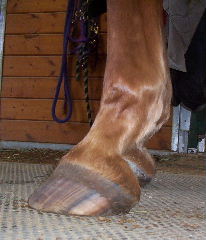 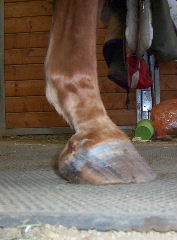 Ran out of memory, can get sole shots if you like. |
| Member: scooter |
Posted on Wednesday, Mar 31, 2010 - 7:08 pm: You are getting there Aileen . Have you been using the riders rasp? . Have you been using the riders rasp?
|
| Member: sunny66 |
Posted on Wednesday, Mar 31, 2010 - 7:17 pm: I use the "real" rasp on his left front because that seems to always need more, riders rasp on the other three. His heels are staying back in the hinds, but not in the fronts so I need the farrier to come out and do that. I also think he needs a balanced trim behind, he's growing a lot of hoof Finally! Finally! Here's his left hind, before I ran out of memory... 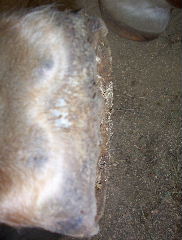 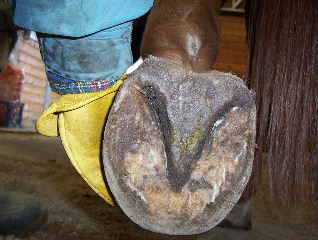
|
| Member: scooter |
Posted on Wednesday, Mar 31, 2010 - 10:24 pm: What little I know I would put a stronger bevel on that toe and actually all around.Exactly why I don't like boots as I've said before.. you end up collecting 100's of them and none of them fit eventually! We really should have a boot borrowing section for people who are transitioning their horses or having hoof problems! |
| Member: sunny66 |
Posted on Thursday, Apr 1, 2010 - 6:18 pm: Ha, yes, I have some softrides to add to it!Farrier came today, asked her to bring back the heels on the front and take off some toe behind - with NO nippers. I also told her about the sole issue that perhaps that's something we need to rule out. Not sore... yet anyway! Here we go: Left front: 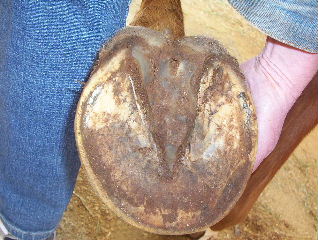 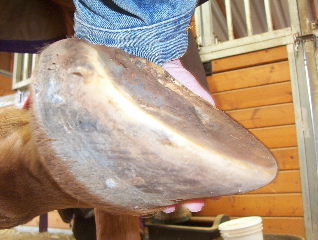 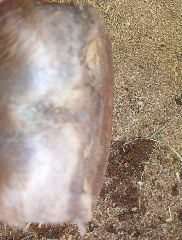 Right Front: 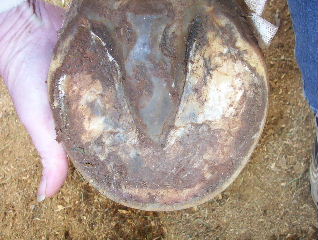 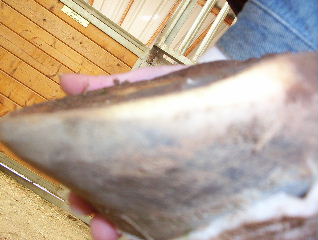 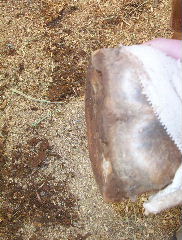 While I haven't seen his fetlocks so puffy in ages, this was the first time in months she's done him without bute or banamine in his system. He is on equioxx, but usually it's just not strong enough... 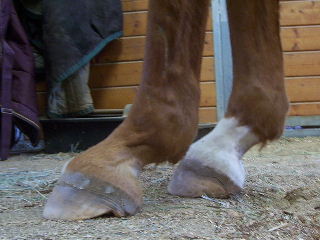 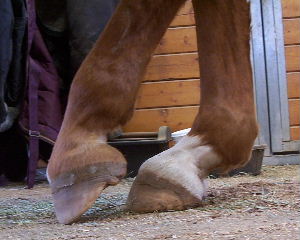 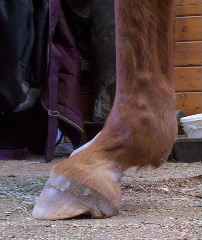 I *think* the right hind looks a bit better... thoughts? He was thrushy again -- bad mom -- so she had to take a chunk out of the outside hind hooves; but I wonder if that will help him straighten out behind? |
| Member: vickiann |
Posted on Thursday, Apr 1, 2010 - 7:35 pm: WOW, the hair line on that last photo DrOps off severely at the heel.On the earlier photos recently posted I thought that the hair lines looked somewhat better. The later photos show really bad DrOp off at the heels. Yikes! Whatever the mechanics are to fix this it sure looks to me like you still have significant correcting that needs to be done. I'm with you all about the boots. We could probably have an exchange for better fitting! I still have not overcome the problems of having my horse stalled in shavings and in boots on the front feet. |
| Member: scooter |
Posted on Thursday, Apr 1, 2010 - 10:46 pm: HMMM your farrier took a chunk of hoof wall off for thrush?? I've never heard of that before, quick cure I guess . . I don't know what to say about his hooves, other than they just look uncomfortable. Aileen I know you have had problems with his hooves forever Like I have with Hank, and you were taking pictures. Do you have any pics of his hind hooves before the fetlocks started DrOpping and froward to now? That may tell you something. In a way I'd be tempted to let his back hooves grow out a little so that there is something to work with.. dunno. |
| Member: scooter |
Posted on Friday, Apr 2, 2010 - 8:14 am: I was looking at Braves Pics again and it appears he hardly has any collateral grooves, even back by the heel. Is this abnormal??? |
| Member: rtrotter |
Posted on Friday, Apr 2, 2010 - 8:20 am: Diane,I was just thinking the same thing. To me it appears that everything looked better before the farrier trimmed him. I think I would do just what was necessary to keep him level and balanced and not do anything else for a while. Let the horse tell you what needs to be done. Sometimes you need to see what the hoof is going to do and not anticipate a problem or attempt to fix it. Aileen, I think I would continue doing what you are doing and maybe skip the next trimming cycle. I'd try him on just the maintenance trims you are doing and see how he progresses. I think one of the reasons your horse was sounder for this trim was the work that you did in between regular trims. It more aligns with what he would be doing on his own, if his environment was perfect. Its one of the reasons why I do not like cyclical trimming cycles. I don't think these cyclical cycle trims address what we are trying to do with these horses and more often than not, the horses go sore because the changes that happen during these cyclical trims are too drastic for that particular horse. It also comes down to the bang for the buck theory, most owners are not happy if their "hoof professional" charged them to trim their horse and did just about nothing, but in reality that is just what you want to happen. If the horses feet don't need a lot of work, then you know you are accomplishing what you wish to accomplish on your own. I do not know why we need the "seal of approval" from our hoof professionals, when all we really need is confidence in ourselves. Just my two cents worth. Rachelle |
| Member: mrose |
Posted on Friday, Apr 2, 2010 - 11:38 am: I have been following your thread on Brave, Aileen, and Diane's, Rachelle's and other's threads on their horses' hooves. I just wanted to thank you all for taking the time to put up the pictures. Following and seeing all your problems, trials and progression is very educational. I'm learning a lot and imagine a lot of others are too.btw - love the idea of a boot "lending library!" |
| Member: sunny66 |
Posted on Friday, Apr 2, 2010 - 11:41 am: Thank you Vicki, I know that he's still got a way to go when I said his right hind looked better, I should have clarified the fetlock when I said his right hind looked better, I should have clarified the fetlock  Diane, he had seedy toe there, she had to get all the black out, she kept digging until there was no more black. It's a good thing she did because if I'm not mistaken it could cause big issues if not taken care of. I ran out of apple cidar vinegar, and I never got to the health store... totally my fault because he wasn't being treated. I have to say though that I only noticed a small bit of it, I didn't realize it was so bad, I will be more vigilant. His fetlocks are better with a shorter toe. His collateral grooves are actually not bad. Still not where I want them on his right front, but the other three feet are ok. Hoofpick goes over half way down when picking. So that's over 1/2 inch with 3/4 inch being ideal, right? Hi Rachelle, remember she hasn't done a major trim on him in months. For me, I would much prefer a comfortable horse, no matter the cost. If it turns out that I can help that happen, all the better  That said, if I had not called her and she didn't find the seedy toe and eliminate it, and I didn't see it, what would have happened? It would have seeped farther up is my guess, then he would have had yet another issue. I understand what you're saying about confidence, and I have gained some, but I still don't know enough to be on my own, so to speak. Hence my question, does measuring the hoof from the coronet band to the toe make sense, and just keep that in check? I'm going to see if I can just use the riders rasp so I don't worry about using the real rasp incorrectly. That said, if I had not called her and she didn't find the seedy toe and eliminate it, and I didn't see it, what would have happened? It would have seeped farther up is my guess, then he would have had yet another issue. I understand what you're saying about confidence, and I have gained some, but I still don't know enough to be on my own, so to speak. Hence my question, does measuring the hoof from the coronet band to the toe make sense, and just keep that in check? I'm going to see if I can just use the riders rasp so I don't worry about using the real rasp incorrectly. He is not lame this morning, didn't give him pain meds last night but I'm certain it's still in his system. But he is being careful when walking on rocks. I thank all of you so much! I know it's hard to do this via the internet but I truly appreciate your input!! |
| Member: sunny66 |
Posted on Friday, Apr 2, 2010 - 11:46 am: Hi Sara, how are you and your herd? If it weren't for Diane, Vicki and Rachelle helping me you wouldn't be learning as much  It's their input that increases the educational aspect, so thanks again to all of you It's their input that increases the educational aspect, so thanks again to all of you 
|
| Member: scooter |
Posted on Friday, Apr 2, 2010 - 12:33 pm: Aileen I think I would start being critical of your farriers job. I remember you stating that he was always sore when he was trimmed until he was about to be trimmed again... that is a red flag for me anyway, because I had the same vicious circle with Hank. I almost dreaded farrier day knowing he wouldn't be able to walk for weeks after he left.I blamed it on all Hanks hoof problems (and he has plenty) but after really scrutinizing (HA made me!) the trim it was just that...not his pathologies. The farrier wasn't trimming him right. I don't know what you have available as far as farriers, I have none! but I think I would have a second opinion of his hooves if you have something like that available. Maybe it is just the pics, but he actually seems to have plenty of toe on all his hooves, his angles and heels just look off, even with the DrOpped fetlocks. How long have you had this farrier? and do you have pics of what his hooves looked like around when she started doing him? It's always helpful to see where he started at and if they are improving or getting worse from when she started. If you are like me you have hardly an idea what a good trim should be... I am learning! I always thought Hanks hooves looked good when the farrier was done...even tho he couldn't walk! I think Brave probably isn't sore because she didn't use the nippers. That was my FIRST awakening, when I told the farrier not to use the nippers on Hank...thanks to Rachelle. When he used them at his last trim..Hank couldn't walk again... I don't know if your farrier is doing a good job from where she started, but I would start studying to make sure he isn't getting worse instead of better. |
| Member: sunny66 |
Posted on Friday, Apr 2, 2010 - 1:00 pm: Right now the only second opinion I could get would be the clinic farrier, and he would tell her to shoe him... not going there. Barefooter MAY be coming up in a couple of months to check him.I understand what you all are saying, she's not good enough. But I think she is. The fact that she listens and does what I ask is priceless. The problem being is that she is the one with the hoof in her hand, you all are going by pictures (taken by me and I'm not very good at it). For instance, I have no idea what I would have done with the seedy toe. What should have been done? I have a ton of pictures of his front feet, but nary a picture of his hind feet. All that see his feet think they are ok. Vet/chiro came out when the shoes first came off and she did a little "uh oh"... but now she approves. She works with the retired farrier that mentored my farrier into curing Brave's navicular. So she knows of which she speaks. He is no longer consulting so he's not an option. To be honest, I thought you were going to like what she did to his front feet. She beveled and made sure she didn't take more hoof wall so his sole wasn't on the ground, which is what I asked because that is what you all suggested, and it worked! So more suggestions are more than welcome! He needs a balanced foot behind in order for his fetlocks to not look so bad. I believe that is what she did. I also believe she wouldn't have taken so much heel behind had he not had the seedy toe. That is MY fault. I agree with her that he needs the seedy toe taken OUT and am kicking myself for neglecting to treat him. You couldn't see the seedy toe from the pictures I took before, I couldn't see it either. But she could. Dr. O, what should have been done with that seedy toe? |
| Member: kpaint |
Posted on Friday, Apr 2, 2010 - 1:03 pm: I'm with you Diane...might be time to locate a trimmer. I was starting to dread the farrier too, (and I like the guy; he's real nice), but I look forward to the trimmer. Not one of the horses has been sore/lame after the trimmer. Diva mare was almost always sore after the farrier. The horses actually seem anxious to lift their feet for the trimmer and grateful. No lie. I'm not exaggerating. Surely it has to be because their feet feel better.I thought Diva Mare's feet looked "good" after the farrier--like Diane. I didn't know what I was seeing. Just saw a nice smooth foot... I don't know about the nippers. My trimmer uses them but perhaps it matters HOW and WHERE they are used and HOW MUCH is taken off? Aileen, what state are you in? Perhaps there is a AANCHP trimmer near you? |
| Member: sunny66 |
Posted on Friday, Apr 2, 2010 - 1:49 pm: Brave loves her, licks and chews after each foot. I actually asked her to look for that, and she does. If he doesn't she revisits the foot.I live in the boonies. Trimmers up here are few and far between. It's hard enough to get a farrier up here that will listen to vets. I feel as though I'm not being heard. She tries so hard and actually asks what I want done, I tell her, she does it (if it applies with her seeing his hoof in person). It worked the last time; so suggestions are welcome. She is a certified farrier that does barefoot trimming on a number of horses in the area with great success. Vets seek her work because she fixes horses, Brave has her perplexed, again, she is open to suggestions which is a heck of a lot more than I can say for the other 6 farriers he's had in the last 7 years. She's been working on him for about 2 years. I don't know how else to get across that she is qualified. I would really like to get back to suggestions for her because the last ones worked! I plan on measuring his toes and keep them where they are at by using the riders rasp and keeping his feet treated for thrush/seedy toe. I really would like to hear what should have been done differently with that seedy toe or wld, or whatever it is. Thank you!! |
| Member: kpaint |
Posted on Friday, Apr 2, 2010 - 3:54 pm: I'm in no position to give advice; I'm still way too new to hoof knowledge. I really like my farrier (#3) and he too is open to what I would like to try. And he is qualifed and certified. And is the vet tech and farrier at Purdue;however, he hasn't had barefoot training. And I'm in no position to teach him, so I luckily found a trimmer. And I'm only 4 months into that experience, but so far so good.I wish you luck and hope you find the magic combination because I can certainly sympathize with you and the anguish we put ourselves through trying to give our horses good foot care! |
| Member: kpaint |
Posted on Friday, Apr 2, 2010 - 4:03 pm: I just reread some of the articles about seedy toe on this site; perhaps have a look at them if you haven't already? Seems like everything I've read or seen says to remove all of the diseased part, icky stuff and treat for thrush. |
| Member: stek |
Posted on Friday, Apr 2, 2010 - 4:29 pm: Aileen yes removing diseased tissue is the appropriate treatment for WLD.I think the proof is in the pudding. If Brave walks off sound after a trim then she is at least doing no harm. If he is always sore after a trim then it's time to re-assess. He doesn't have perfect feet but really, who does?! To my eye the fronts look like she did a decent bevel, the sole plane looks fairly even. Looks like he has a bit of flare toward the quarters but if you keep after that area between trims it might help it. I can't speak to the hinds as I have no experience dealing with DrOpped fetlocks. |
| Member: sunny66 |
Posted on Friday, Apr 2, 2010 - 5:11 pm: Thank you Vicki, back in 2007 I worked with barefooters here and other barefooters online to fix his navicular. One barefooter came out to give advice to my farrier, which my farrier wanted and successfully fixed his navicular in both front feet I know she would be up to it again and when this barefooter can make it out, it will happen. The online barefooters were actually excited that there was a farrier that wanted to learn about barefoot. My farrier knows I "talk" with barefooters about my horses' feet, this is why she asks me for opinions. She knows that there's a basis for my thoughts. I know she would be up to it again and when this barefooter can make it out, it will happen. The online barefooters were actually excited that there was a farrier that wanted to learn about barefoot. My farrier knows I "talk" with barefooters about my horses' feet, this is why she asks me for opinions. She knows that there's a basis for my thoughts. I thank you for your good thoughts   Shannon, thank you very much! When rasping flare, I still need to take care not to rasp into the white line, correct? So if there's a flare but it's near the white line I should leave it be? I do look for laid over bar that may be causing the flare and take out what I can with a hoof pick... not going to use a knife yet! I know I should square the hind toes, should I square the fronts as well? Would that help the underun issue? Also, should the front feet be round and the hinds more of an oval shape? Thank you!! |
| Member: sunny66 |
Posted on Friday, Apr 2, 2010 - 5:29 pm: Regarding the navicular, just to clarify it was the master farrier, my farrier, and the barefooter combined that fixed him. My farrier took what she thought pertinent, to my horse, from each. |
| Member: stek |
Posted on Friday, Apr 2, 2010 - 5:57 pm: I don't ever invade the white line except in cases of disease (and then I have someone more qualified than myself handle it!).Squaring/dubbing back the toes helps breakover, which if it contributes to an overall balanced foot might help with the underrun issue but beyond that I'm not sure they would be connected. Maybe someone else can speak to this? For my own horses I aim for a more rounded front foot rather than squaring the toes too much. The exception to that is for my mare who has a persistent toe crack, I keep after her toes to keep it from coming back. I think the 'ideal' hoof shape is round in front and more oval or even spade-shaped in the back (wider at the heel). But personally I think each horse has his own natural foot shape so I don't worry a whole lot about chasing an ideal. One of my horses has completely round front feet and another completely oval front feet and they are both quite happy and sound barefoot. For me that's the biggest thing! |
| Member: scooter |
Posted on Friday, Apr 2, 2010 - 6:45 pm: Aileen you are absolutely right, you see the horse and his hooves everyday. If you think they are improving then you should go by that. With his DrOpped fetlocks it is hard to tell what to do to those hooves, I'm definitely not experienced enough to know. My suggestion was to educate yourself so you know what Brave needs, and you know it is being done right.I don't know as far as seedy toe, which is actually focal areas of thrush I believe... I have never seen it treated that way. I have only seen it dug out and treated like thrush, not the whole hoof wall taken, but maybe your farrier saw something there, Dunno. Regarding Navicular disease I was under the impression that it is not "curable" but degenerative and chronic. Aileen I am just saying don't take everything at face value, research your questions. Hank loves my farrier too, he licks him and kisses him, and thinks he's great. I like him too. He is going to learn right a long with me, I just wish I had one that already had the knowledge and I didn't have to deal with it.. as we all do I'm sure! I hope Brave continues to improve! |
| Member: sunny66 |
Posted on Friday, Apr 2, 2010 - 7:46 pm: Thank you very much Shannon, that helps me a lot! Hi Diane, rest assured I do not take everything at face value, hence my continuous request for suggestions  Finding a reputable protocol for dsld is not easy, there are more than 50 different opinions out there, the one constant is to keep the foot healthy, balanced and in good form. That's what we're trying to do, it's been trial and error but finally, thanks to you and Rachelle, we've gotten somewhere with the front feet! Who knows, once the front feet are fixed his hind end may get better... hey, I can hope Finding a reputable protocol for dsld is not easy, there are more than 50 different opinions out there, the one constant is to keep the foot healthy, balanced and in good form. That's what we're trying to do, it's been trial and error but finally, thanks to you and Rachelle, we've gotten somewhere with the front feet! Who knows, once the front feet are fixed his hind end may get better... hey, I can hope  There's navicular disease and there's navicular synDrOme, I believe he had the synDrOme - otherwise called caudal heel pain, I think anyway, not sure. His navicular xrays showed slightly more than normal changes for a horse his age and he had symptoms of navicular: lame, not crossing over the other foot when turned tightly, at his worst: hopping in order to keep his weight off his feet, etc. He hasn't fully shown these symptoms in a few years; however, he did indicate to me a while back that he's on the verge. Since his heels are not bent over in the front feet, those indications have not been seen again. Whether he's improved or not from the recent trim, I won't know for a few days. But at least he's not worse. Thanks Diane! |
| Member: vickiann |
Posted on Friday, Apr 2, 2010 - 8:53 pm: In my experience, "navicular" is a catch all phrase.I've got a 23-year old guy long ago diagnosed with the synDrOme who has had every shoeing remedy known to Vets and farriers. He was NEVER sound and frequently lame until my current farrier fixed him after all of these years! He has been going well now for 2 - 3 years after never really being sound before. |
| Member: scooter |
Posted on Friday, Apr 2, 2010 - 9:55 pm: Aileen I think you are right, if you can get him comfortable in front it will do nothing but help the rears. You have a good start, keep beveling. Square toe, round toe, isn't as important as keeping his toe beveled and helping his break over.A squarish toe helps Hank because of his stretched WL (which is really getting better) finally. From what I understand so take it FWIW you should not bevel into the WL unless there is a stretched WL or flare. I do start my bevel on Hank at the WL, but his hoof is different than Braves. Aileen out of curiosity what is that kind of hanging there at the heel where she removed the wall.. and also where I put red lines are they lines in the hoof wall. I'm pretty sure the right is but not sure about the left. 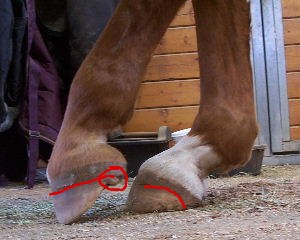
|
| Member: rtrotter |
Posted on Friday, Apr 2, 2010 - 10:35 pm: Aileen,I have 35 years as a professional racehorse trainer, so I have come across a lot of horses with a lot of different conformational and hoof problems. I had one horse who despite all my trying and different types of feed supplement and foot preparations would not grow any heel purchase. She was the one who first got me into all this barefoot stuff and it was her who taught me that in order to get her feet right she needed heels. The problem was I was going about it all wrong because I did not understand what her foot was trying to tell me. This mare would grow toe and no heel and as soon as her toe got just a bit too long, her gait would suffer, so I had to get her shod every 10 days, very costly, but at the time I was all I knew how to do. I also tried to either square or blunt her toe to give me a few more days on the shoes before I had to get her done again. What I wound up with was a stubby toed shod horse that looked great for a few days and then back we would go into the long toe low heel synDrOme. Looking back at it now, what caused this to happen was the farrier finishing off the foot( to make it look pretty) and taking too much wall at the toe from the top when he was squaring or blunting it. What that did was make her grow more toe, because her body was telling her that that part of her foot needed more protection. I finally stopped with her pulled her shoes and started my search for a trimmer that I could get along with ( and her to, she did not like picking up her hind feet, gee I wonder why). When I found my present trimmer, it was he that explained the only way to get heel purchase was to balance her feet and bevel her toes(and the rest of the wall). It took three trims about 2 1/2 to 3 weeks apart( about 9 weeks total) for her to start having normal looking feet with heels and concavity which to my surprise also resulted in a shorter more compact hoof without having to square or blunt her toe. The best part was she got her gait back, quit crossfiring and was much happier attitude wise until I had to go back to shoes and my saga began again. Why am I telling you this because your horse has the same kind of feet I started out with with my mare. The problem wasn't the toe although fixing the toes with the correct bevel straightened out the problem. The problem was no heel purchase and I think that his DrOpped fetlocks is his way of telling you that his heels need to be fixed. Once his heels are fixed that will remove some of the strain on his suspensory ligaments and may allow him to be more comfortable and straighten up a bit. So, my suggestion to you since your farrier was just there would be to just bevel the toe with your riders rasp as part of your regular hoof care ritual, but first give him a few days to make sure he is not sore from the trim. I would not do anything else to this horse other than his toes and I would watch and see if his heels don't start to correct themselves just from the beveling. I think from looking at your pictures your farrier while well meaning, does not know how to put a proper bevel on a hoof and that is creating a problem, since she's willing to learn I think thats a plus. I also think that your horses heels are the source of his navicular synDrOme problem and getting him up will help that too. Sorry this was so long, but I had to get it out and I have had slow typing( UGH!) all night. Just my thoughts Rachelle |
| Member: mrose |
Posted on Friday, Apr 2, 2010 - 10:57 pm: Aileen, doing o.k. Soon as I get some time I'll sit down and post on Sahira's thread. I've been roundly scolded by my dr for being on my foot too much. Did get to the vet's again with Sahira, so will report in the next day or two. Did get to the vet's again with Sahira, so will report in the next day or two.
|
| Member: sunny66 |
Posted on Saturday, Apr 3, 2010 - 11:37 am: Thank you Shannon! Thank you Diane, I'm not sure what that is - wall that's not diseased? Will take another look/pic today. I believe those lines are stress lines, I'd say laminitis, but I don't think he actually had laminitis... poor guy. Though it was back in May that he wouldn't pick up his feet. It was December that we took off his shoes behind, stress from that maybe? I don't know. He was sensitive to the hoof pick yesterday... I was being pretty aggressive since it was raining and he had a lot of gunk in there, but after applying the acv/tea tree oil 3 times yesterday, not as sensitive this morning. Rachelle, thank you so much! I appreciate the time you took to type all that and it truly sounds exactly like what we've been going through. Your suggestion to just rasp toes seems a logical way to proceed. I feel safest only doing toes, but what about that flare? I will take more pictures today and try to clean the wall/white line really well so you all can tell me if I should rasp that flare or not. I will be picking his feet am/pm and applying the acv/tto for quite a while. I was using the riders rasp every four days or so, is that sufficient or should I use it every couple of days? THANK YOU!! Hey Sara! What did you do to your foot!!??? |
| Member: rtrotter |
Posted on Saturday, Apr 3, 2010 - 12:18 pm: Aileen,Every 3 -4 days is fine and if you use the riders rasp you should be fine. If you are going to use a regular rasp make sure you do it from the bottom and finish it off just on the sharp point of the wall. You can bevel the wall to deal with the flares but your main focus should be those toes. So your schedule might be toes every three days and flares every 5 days or something like that. I am telling you when I finally figured out(with the help of my trimmer) what my mares problem was and how to fix it, I had one of those epiphany moments like Diane had with Hank. Then watching the hoof form improve and seeing soundness and gait return was the second epiphany. I am so glad I found barefoot, now the rest of the journey is on its way to being complete and I hope that everyone finds the same sense of satisfaction that I get, knowing I can help my horses and keep them racing at the same time. Rachelle |
| Member: sunny66 |
Posted on Saturday, Apr 3, 2010 - 10:48 pm: Thank you Rachelle, I hope I get to feel some of that satisfaction... and soon!! lol I will use the riders rasp as you suggested and see what happens Diane, I didn't get to pictures today, hopefully tomorrow. But I did take a good look at the hoof and didn't see anything hanging, so I'm not certain what that is in the picture. Today he's landing heel first in front and flat behind, just fine on rocks, no ouchiness. Improvement and no pain meds for 48 hours. Put him back on them tonight though. So thank you again for helping him  
|
| Member: scooter |
Posted on Sunday, Apr 4, 2010 - 8:52 am: Aileen why are you putting him on pain meds if he isn't in pain? I could never wait to get Hank off of them. I think Rachelle gave you very good advice, what little I know. I would use the RR on him every other day until you get a good bevel..then back off to a couple times a week to maintain. If he is on pain meds you won't know the results for sure. I think you are on the right track Your farrier trims a bit like mine so keep an eye on her!!! Your farrier trims a bit like mine so keep an eye on her!!!
|
| Member: sunny66 |
Posted on Sunday, Apr 4, 2010 - 11:28 am: Hi Diane, he's on pain meds because he can't get up without a lot of pain and three vets have prescribed it even though when two vets saw him in person Brave was sound at three gaits. One vet said that he has had calls from owners that didn't put their horse on pain meds to put them down because the horse couldn't get up. He didn't understand why owners won't use pain meds. Because of his belly issues I was one of those owners, until I saw him get up. If you saw him get up while not on pain meds, you'd understand. It's absolutely heartbreaking to see my beautiful boy struggle so much.I got some input from another barefooter and she said that maybe the white line connection deteriorated. She said once the connection is lost you can't get it back. She said he didn't look terrible and that it would grow in nice and tight and I should keep the quarters high to keep the bulge from coming back again. She was actually glad not to see the bulge. Everyone is out to get some grazing in before the rain hits this morning. Will get some pics today. |
| Member: rtrotter |
Posted on Sunday, Apr 4, 2010 - 1:13 pm: Aileen,Can your horses weight be contributing to the fact that he can't get up or down easily and if so its time to get it off. Is he rideable, I'd be putting him back in some sort of exercise program even if its just a little bit at a walk. Also, I use a product called OCD pellets that I have had really good results with. I had an older horse (13) who had been through the racing wars with other people, had suspensories on both hind legs and an ankle the size of a very large grapefruit and he was a big horse. I put him on OCD pellets, fixed his feet and put him on a light exercise program within 3 weeks I had a different horse and he was back racing after 18 months of being so lame and sore, he could hardly move. ( I did not have him for most of those 18 months, only the last few). The OCD pellets was the only thing he was on, no other meds (even when racing) and I saw a huge difference in a few short weeks. So, I am not firmly convinced that Brave needs those pain meds( I know this has come up before, in this discussion)especially if you have taken him off of them and he seems to be sound without them. Taking the weight off him will probably help more. Just my 2 cents worth. Rachelle |
| Member: scooter |
Posted on Sunday, Apr 4, 2010 - 1:39 pm: The weight makes a big difference and being comfortable on his hooves. Remember I told you my mare could hardly get up, was horrible to watch..even on bute. With weight loss and getting her back hooves better that changed. She was exactly as you describe Brave. She still will walk off a little stiff and occasionally raise a leg, but getting up and down she does well.. considering everything. She does flop a bit when she goes down . I don't see her lie down often but by the shavings on her coat she does everynight. I have seen her rolling in the mud lately, while she doesn't get up like a 2 year old, she doesn't struggle much either. Somedays it takes longer than others, but she manages just fine. I would think if it pained her she would be reluctant to roll OR lie down. . I don't see her lie down often but by the shavings on her coat she does everynight. I have seen her rolling in the mud lately, while she doesn't get up like a 2 year old, she doesn't struggle much either. Somedays it takes longer than others, but she manages just fine. I would think if it pained her she would be reluctant to roll OR lie down. Have you seen him get up or roll the 2 days he was off the meds? |
| Member: sunny66 |
Posted on Sunday, Apr 4, 2010 - 3:12 pm: He is on an exercise program and diet... the exercise has diminished with the crazy weather however. He moves more while on pain meds, doesn't use his engine as much without them. Moving more and correctly helps him.You both are asking me to go against three vets. Two of which are highly experienced and sought after in the area; one is a lameness specialist and has worked on a number of horses with DSLD/ESPA. If Dr. O chimes in and agrees with you I may consider it. He wasn't very cooperative but as I said big storm front is moving in. This is all I could get. 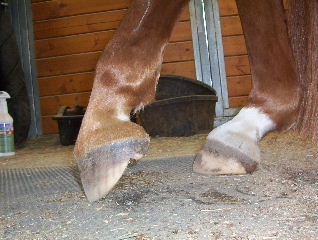 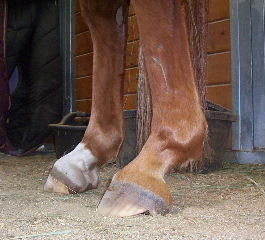
|
| Member: scooter |
Posted on Sunday, Apr 4, 2010 - 3:29 pm: NO NO not asking you to go against any vets! Sharing my experience . His fetlocks look good today, Getting his front hooves straightened out is really going help that back end I bet. . His fetlocks look good today, Getting his front hooves straightened out is really going help that back end I bet. I guess Rachelle and I like to experiment more than most to see what makes them more comfortable. I have never been a big fan of nasides if not needed JMHO. I listen to my vet all the time, but I am the one who sees them daily. When Sam was sick he told me to keep him on nasids.. even double what I was giving him... I SAW that that wasn't necessary and didn't, however that was my judgement call from seeing him daily and he could easily be put back on them, if I thought he was worse. Things change, did you see Brave get up and down when he was off nasids?? Our suggestion was since we changed things up (like you are doing with the hooves) the horse no longer needed Nasids. Always consult your vet if you have questions... we are just giving OUR experiences, You never know with Braves increased comfort he may not need it, then again he may.. you and your vets call... not ours!! |
| Member: scooter |
Posted on Sunday, Apr 4, 2010 - 3:33 pm: PS maybe Dr.O. or you can answer this, but I thought when I was reading up on DSLD, nasids don't help with the pain of it?? That's why I figured they didn't help Flash and yes I believe she has DSLD or DrOpped fetlocks from old age maybe... they look just like Braves. |
| Member: sunny66 |
Posted on Sunday, Apr 4, 2010 - 3:46 pm: Thanks Diane, I get that experimentation is good, and trust me I have, but we are just beginning to rebuild him (lol that sounds like the bionic man/horse!). I don't think he's ready yet. I don't want him compensating anywhere. Again,if Dr. O feels it's warranted, I may question further.Just out of curiousity I went back to some September pictures. Big difference I think: 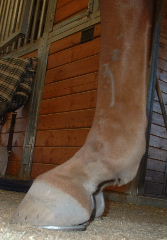
|
| Member: sunny66 |
Posted on Sunday, Apr 4, 2010 - 3:48 pm: Remember Diane, he also has arthritis in his stifles, hocks, and now fetlocks. He has a double whammy... |
| Member: scooter |
Posted on Sunday, Apr 4, 2010 - 3:54 pm: That's why you are the best judge, don't think Dr.O. will be up for that call either Something you have to decide along with your vet. Something you have to decide along with your vet. How long has he been on Nasids?? |
| Member: scooter |
Posted on Sunday, Apr 4, 2010 - 4:52 pm: I may be wrong, but I think his hooves looked better in Sept. the fetlocks hard to call from the pics. Don't know, but you are trying and that's all you can do
|
| Member: sunny66 |
Posted on Sunday, Apr 4, 2010 - 5:42 pm: He's been getting equioxx for about 60 days, every other day for the most part unless he's lame then every day, sometimes every two days, but never longer than that. Just enough to take the edge off his pain so he can get up.I make sure to treat his liver, stomach and kidneys with accupressure every day, also the ligament, hock and stifle points - seems to help, it may not, but at least I feel like I'm doing something ... lol. He seems to like it anyway. I thought today he was standing much more comfortably with weight over the entire hoof. His hooves were underrun in September, and if I remember right, landing toe first. Now he's landing flat, or heel first depending on the terrain. He cantered in sound (not hopping behind) and full of himself today, granted it's howling wind but he looked just beautiful. And yes, I did tell the vets that when on pain meds that he feels good and gets goofy and may overdo it, but they all felt that helping him get up was more important. I'd still like Dr. O's opinion ... |
| Member: rtrotter |
Posted on Sunday, Apr 4, 2010 - 6:45 pm: Aileen,Not sure where you got the idea that I wanted you to go against three vets. All I said was that he needed to lose weight and suggested an exercise program and a product that would help probably all of his problems without being on prescription meds. The fact that you have him on a diet and he is getting some exercise is a good thing. The fact that he is sound is a good thing too but, I would caution that it may be the meds that is doing that. You are the best judge of your horse, so I am sure you will take care of him in the best way possible, but I, like Diane, sometimes make decisions that are contrary to what the vets suggest, I am not saying that every one of those decisions comes out perfectly every time, but a good majority of them do. I tend to trust what my horses tell me and as long as I listen to them things tend to work out. I would try the OCD pellets along with the Equiox and then see if you could wean him off the Equiox or at least have a longer time frame between treatments. Might help save his stomach too. As far as his feet go, they did look better in the earlier pictures even with shoes on, the angles appear to be better, but I can't tell about the fetlocks because I can't see the rest of the horse. I wish you all the best and I am sure that you will and have been doing the right things. I'm sure Brave appreciates it. Rachelle |
| Member: sunny66 |
Posted on Sunday, Apr 4, 2010 - 8:30 pm: I got the idea from both you and Diane that I should stop giving him pain meds, sorry if I misinterpreted. He was sound while off pain meds, just not using himself correctly. But technically it's not the soundness he gets the pain meds for, it's for getting up. He's always sound for vets so we can't block it out. Since he's sound, and I don't have a webcam at the barn so I can't always see him get up, I don't have anything to judge by and I hesitate to experiment at this time.I still think he's standing better now, also see that bump on the front of his leg where the pastern meets the fetlock in the September picture? It's not there now. It's smooth. Xrays showed him not standing under himself behind back in January; I think I'll wait another month and get another xray done to see if I'm seeing things. I do listen to him daily, and he has a lot to say. I have learned that much during this saga  He is currently on almost all the ingredients in the OCD pellets, smarttendon, conquer gel, etc. I know these work because when I take him off them to see if they work, he gets worse. The only thing he is not on is sulpher. Unless sulpher is in msm. But I will ask my vet about the ocd pellets and see if sulpher would make a difference and if I could add them to what he currently gets. Thanks Rachelle 
|
| Member: stek |
Posted on Monday, Apr 5, 2010 - 12:27 pm: Aileen .. yes MSM has/is sulphur.Just wanted to add my agreement that getting weight off Brave is probably one of the best things you can do for him. In the conformation shots at the top of this post he looks like a chunky guy by nature  Also, I pasted together a few pics of Brave's feet and copied in below. Thought it would be helpful to view them side by side. IMO the farthest left pic is when he looks the best as far as his pasterns go. In the pic with him shod the heels look pretty underrun, and the latest pic his angle looks pretty step though the heels look better. Would be curious to hear others' opinions. 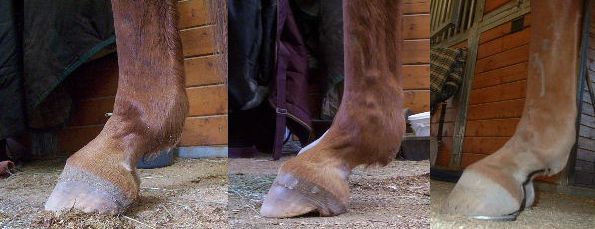
|
| Member: scooter |
Posted on Monday, Apr 5, 2010 - 2:05 pm: When was the first pic taken?? IMHO I think his hoof and fetlocks look MUCH better in that one. If that is first in the series date wise it would APPEAR his heel is getting worse. Look at the hairline slope and curve down in the last 2, and how much "bigger" the fetlock looks in the middle pic (most recent). It APPEARS as if he has no base for support in back??? In the first pic his heel isn't hardly under run at all, just a tad tall. HMMMCurious what others think too. |
| Member: stek |
Posted on Monday, Apr 5, 2010 - 2:30 pm: Diane I took that from the Feb 27 post in this discussion.The order of the pics is: Feb -- March -- Sept They are ordered in my own opinion of best to worse, with the Feb being best and Sept being worst. For me it's hard to tell how much his stance in any particular pic, how he is weighting the foot, is affecting the appearance of the fetlock. |
| Member: stek |
Posted on Monday, Apr 5, 2010 - 2:44 pm: Just for perspective here is a pic from the same day as the 'best' pic above next to the most recent. So these are Feb -- March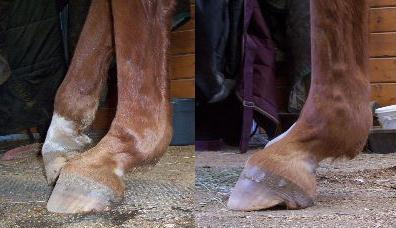
|
| Member: sunny66 |
Posted on Monday, Apr 5, 2010 - 3:27 pm: I agree that of the three above in Shannon's great visual Thanks!! that I like the first picture as well; however, the middle picture is just after the farrier came, he is always worse behind after the farrier. The day his fetlocks are not bad after the farrier I will think progress is finally being made. Thanks!! that I like the first picture as well; however, the middle picture is just after the farrier came, he is always worse behind after the farrier. The day his fetlocks are not bad after the farrier I will think progress is finally being made. This is the most recent, four days after the farrier: 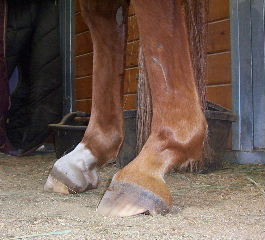 I asked a barefooter if she saw improvement between the Sept and the picture above: "Yes. I like how his fetlocks look more defined. Less puffy. I *love* how the heel is looking in the updated shot. The heels are back. The hair line is not arched. Although the way he's standing...his cannon bone isn't 90deg to the ground, it looks like he is able to weight the heels better." |
| Member: scooter |
Posted on Monday, Apr 5, 2010 - 5:01 pm: Gotta agree just too hard to tell from the pics, You are dealing with DrOpped fetlocks ect. So it is very hard to judge and we do not know if they are weighted the same. So just for the sake of learning let's get rid of the fetlocks for now and just see what the hooves are doing.Aileen I am soo learning with you so this is just all a guess, but how can one learn without questions so here goes Red line is hairline, in the most recent pics I see one that is bulging a bit in places, with the black circle above showing "puffiness" above the coronet band.. jamming???? The black line below the hairline is some sort of stress line. Sam and Hank had the same thing when their heels were quite underrun., if someone made me guess I would say Brave is standing on part of his heel bulb right now. That is all a guess, and just the hooves, other things probably should be taken into consideration. Sorry my lines are kind of squiggly!  
|
| Moderator: DrO |
Posted on Monday, Apr 5, 2010 - 7:24 pm: The answer to the question seems straight forward but you must consider two parts: First, "does he?" or "does he not?" seem more comfortable on doses of NSAID's. And is the risk of NSAID toxicity vs the pain relief you perceive seem acceptable? If yes to both questions you would continue them, if not I would stop.DrO |
| Member: scooter |
Posted on Tuesday, Apr 6, 2010 - 7:23 am: Aileen Sam also had hooves similar to Brave in back, his fetlocks were so sore and swollen he couldn't stand me touching them. he has very short pasterns so DrOpping was minimal. He shifted weight in back, cocked on hoof a lot. ect. Here's a pic of Sams hoof, I did ask about them on here because he had that "stress" line"Sams are the all black ones. https://www.horseadvice.com/horse/messages/4/122316.html |
| Member: sunny66 |
Posted on Tuesday, Apr 6, 2010 - 11:22 am: Ok, thanks Dr. O.Thanks Diane, you know looking at the pictures you posted of Brave's hooves, while I believe the coronet band is straight, there is a bit of indention at the front where you noted. I don't know what that is. His coronet band is firm, not soft and spongy, but the indention is soft. Also looking at the pictures you posted do you see those squigley lines in the hoof wall just above where she cut out the hoof wall? Now look at the most recent pic, they are almost ironed out now. It's amazing to me how fast hooves can change. |
| Member: scooter |
Posted on Tuesday, Apr 6, 2010 - 4:05 pm: Aileen IMHO the lines may be straightening out because the "stress" was removed... not quite the way it should be. When his hoof hits the ground again it will happen again if the trim isn't changed to relieve the quarters a bit, notice the bulge above the coronet band where she cut the quarter out.I am not experienced enough to tell you what to do, I have my own problems figuring out Hanks hoof!!! SO take this FWIW and hopefully someone that knows more will correct me if way off base. I don't know how your farrier is "moving the heel back" but to my eye (from the pics) it looks to be getting longer (more forward) instead of moving back. IF I was FORCED to work on these hooves I think I would be addressing that toe more and relieving the quarters a bit.. moving the Heel base back that way. If you look at the 2 pics I posted you have a lot of puffiness above the coronet at the toe. It APPEARS there is some undo forces at work with that toe and until that is made better, you don't stand much of a chance with the heel. Heel follows toe. I think Rachelle gave you very good advice above JMHO 
|
| Member: scooter |
Posted on Tuesday, Apr 6, 2010 - 4:14 pm: PS if you look at that thread I posted notice how "puffy" Sam is above the coronet band, and not in the after pic. |
| Member: scooter |
Posted on Tuesday, Apr 6, 2010 - 4:39 pm: One more observation and I'm out! I only know enough to be dangerous, but I would like to see Brave get helped. I point this out because I saw the same thing with Sams back hooves when they looked similar to Braves. I think the reason back by Braves frog looks "weird" is because the heel bulb is low and he is standing on the bottom part of it... Sam's looked like Braves and he was reluctant to weight his heels when standing still. the weight switching in back.. he SEEMED to walk OK.Where I circled looks like the bottom part of Braves heel bulb??? Sams was all smooshed there too. 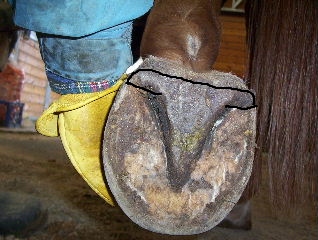
|
| Member: sunny66 |
Posted on Tuesday, Apr 6, 2010 - 4:44 pm: I am getting old, and couldn't tell what you were getting at with Sam's feet. I saw the cracks in the heels, but that was it. Brave is not puffy above or on the coronet band - he used to be months ago, but not now. The hoof itself is soft just below the coronet band at the front of the hoof. What would cause that?I do plan on addressing his toes, that hasn't changed. His quarters are always relieved by the farrier. Do you think she cut his hoof thinking she was relieving his quarters? If so, I highly doubt it. I am confident that she would never do something so drastic without asking me first. Besides, he still has some black in there even treating twice daily, I really think something sinister was/is going on. His quarter bulge has actually gotten much better in the last two months. I used to be able to see it just looking at him, now I cannot unless I take pictures. There is currently very little bulge at his quarters. I really like how his hoof is straightening out at the heel. All those wrinkles can't be comfy. btw, I am looking at the most recent picture I posted as his feet have changed already. However, I do not have a problem with using the older pictures for learning. I do see a bulge on the one you posted. I cannot wait until she gets back from vacation and I can ask her what happened there. |
| Member: sunny66 |
Posted on Tuesday, Apr 6, 2010 - 4:58 pm: Do you mean his frog is lower than the hoof wall? Yup. You can kind of see the black in the hole too.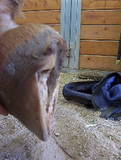 He does switch behind more often when off pain meds, not a huge amount - I probably wouldn't notice if I didn't know what I know now...when on meds he rarely switches. |
| Member: scooter |
Posted on Tuesday, Apr 6, 2010 - 5:57 pm: Aileen no I didn't mean she did that to relieve the quarter, I meant it had the same effect. . . It really sounds as if you are happy with the way your farrier is trimming and the way Braves hooves are going.. you see them everyday so I don't know what more to say except I hope Brave continues to improve as always.. keep us updated 
|
| Member: sunny66 |
Posted on Tuesday, Apr 6, 2010 - 6:39 pm: Ah, got it Happy? well no, I want them to be fixed today, but that's not realistic because it's a process, unfortunately ... I plan on following Rachelle and your suggestions to work on his toes and see what happens. I measured the front at 3.25 and back at 3.5. Happy? well no, I want them to be fixed today, but that's not realistic because it's a process, unfortunately ... I plan on following Rachelle and your suggestions to work on his toes and see what happens. I measured the front at 3.25 and back at 3.5. Farrier just called. She said the connection was lost and he had thrush in there. I also asked her about the front of the hoof - that soft spot - and she said she thought he bumped it on something. I asked her if she's seen that before and she said yes. I asked if it could be a bruise and she said probably. She'll take another look at it next time she comes out for other horses in the barn. She's waiting for me to call her when I want her to work on his feet again. No pain meds last night and the report today is that he's bright and happy, I'll see what I have when I get home. Thanks Diane, sorry if I don't seem appreciative, I am very much so. Everything is something to think about 
|
| Member: vickiann |
Posted on Tuesday, Apr 6, 2010 - 7:22 pm: Aileen,From your recent photo I am wondering if those heels are under-run as they are looking to be so forward, as Perry's were after his long recent ordeal. Lay a rasp straight across the part of the heel that hits the ground and see how much air/light space there is as compared to the bottoms of the heel bulbs. Brave's heels may actually be too high. I cannot help but wonder if Brave's heels might need a few swipes with a rasp to restore them to their proper position, which would be further back than they appear in the photo. If it can be done just one or two at a time a couple weeks apart that might work the best if this adjustment is needed. Read my post earlier today (the first one) about Perry's thrush/laminitis and his trim yesterday. |
| Member: ajudson1 |
Posted on Wednesday, Apr 7, 2010 - 7:03 am: So much interesting information here!I keep thinking his hind feet almost look like snubbed toes? Very weird, I am just going keep following this, and wish you the best of luck. |
| Member: sunny66 |
Posted on Wednesday, Apr 7, 2010 - 10:40 am: Hi Vicki, they are just a tiny bit underrun, remember how bad they were when we took his shoes off? They have improved leaps and bounds. I actually think he needs more heel so the frog isn't taking all the weight, as Diane mentioned above, that's what I thought would fix the whole frog fiasco. Plus the higher the heel the better his fetlocks look...His heels hadn't been so high in ages - will go look at your thread later today. His fetlocks are bad again, going down almost horizontal again. I kept him off pain meds because his body worker is coming tonight and I want him to see his issues. Why is it that when off pain meds his fetlocks are worse, and when on pain meds he looks almost normal? I know I'm repeating myself, but I have to wonder if arthritis is playing a role.Hi Angie, uh oh... I thought he was getting better, not so up and down in the toe as he used to be. He doesn't seem to be dragging his toes nearly as much as he used to. He used to make tracks with his toes, not so much anymore. I hope I won't make it worse with my amateur rasping! So guess what that soft spot could be? It's a liver accupressure point. Not good. It was bad - really soft up into the coronet band - last night, normal this morning. He also dug a hole to china last night. So his liver is bad and he's struggling to get up again is my guess. wonderful. 
|
| Member: stek |
Posted on Wednesday, Apr 7, 2010 - 10:42 am: Vicki not to speak for Aileen but from the pics above he looks to me to be recovering from pretty under-run heels. Not the worst case I've seen but still.Comparing the pics below, on the one with shoes looks to me like the heel was much worse, and the current trim looks like she is working on bringing those heels back under him gradually. 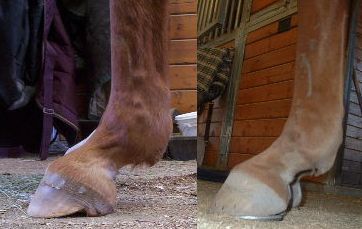
|
| Member: sunny66 |
Posted on Wednesday, Apr 7, 2010 - 1:08 pm: Shannon, you spoke for me better than I did What do you think about the toes? Can I screw them up more using the riders rasp, or is that fairly safe? |
| Member: scooter |
Posted on Wednesday, Apr 7, 2010 - 3:07 pm: Aileen I am going to take a wild guess and say that the reason his back fetlocks are worse off pain meds is because his front hooves may be somewhat sore. Logically speaking, fetlocks don't go up and down with pain in them.. he is weighting them more, logic anyway would point to the front.(of course horses aren't always logical) |
| Member: sunny66 |
Posted on Wednesday, Apr 7, 2010 - 3:35 pm: ACCKKK! Since the ground is so soft I didn't even think of it! He was totally marching around last night at the walk. His right front is F L A T, and his left hind fetlock is worse - so diagonals, right? I'll put boots on him tonight and see if I see a difference in the morning.Thanks! |
| Member: stek |
Posted on Wednesday, Apr 7, 2010 - 6:55 pm: That makes sense Diane .. on meds he is bearing more weight on the front, off meds shifting weight behind. That one had me stumped
|
| Member: vickiann |
Posted on Wednesday, Apr 7, 2010 - 7:18 pm: I have had under run heels in horses that corrective farriers/Vets raised.Nothing could have been a worse remedy. The heels under run precisely because they are too high and have to go somewhere. |
| Member: scooter |
Posted on Wednesday, Apr 7, 2010 - 7:53 pm: HMMM that's interesting theory Vicki. I tend to for the most part disagree tho. There are high heels and there are underrun heels, they can intermingle a bit. ALL my gazillion hours spending reading about underrun heels... tend to point to the toe being too long. If you can keep bringing back a long toe the heels have nowhere to go but back and possibly up, where a balanced trim comes into play. A tall heel can give an appearance of UR heels, but once lowered where they belong and the toe is not long it is a little easier fix than an UR heel.The birth of an UR heel is a long toe usually IMHO. That's why it is called long toe, low/long heel synDrOme they go hand in hand. Unfortunately sometimes it is a very long process sometimes to get those toes back where they belong. It seems I am the only one, but I still don't see Braves heel being better from the progressive pictures above. They were quite UR with the shoe pic, but picture the shoe off and you have the same hoof almost as the recent pics. The shoes seemed to help his angles a little tho. Dunno.. hooves confuse the heck out me!!! and pictures can be deceiving... the landmarks are there tho. |
| Member: vickiann |
Posted on Wednesday, Apr 7, 2010 - 8:10 pm: My horses' worst under run heels took place when the toe absolutely was not too long, Diane.In fact, it likely was when they were perhaps too short. I absolutely do not believe in allowing the toe to become too long, for many reasons. But my old boy Buddy was fixed after being mostly lame for over 12 years by taking his under run heels gradually back. He remains sound on hard surfaces and moves beautifully as he never did in all of his life thanks to my farrier taking back his under run heels. Check this article out: https://www.healthyhoof.com/case_studies/Nick/Nicky.htm |
| Member: rtrotter |
Posted on Wednesday, Apr 7, 2010 - 10:23 pm: Hello all,Vicky, Do you have any foot pictures of Buddy at his worst and at his best? IMO, the cause of underrun heels in shod horses is having extensions on the back of the shoe for"support". See photo of Brave in shoes. The heels have a tendency to grow to meet that support. Since the toes are locked by the shoes, the heels are the only thing that can move and the constant pounding drives the heels down and forward thus becoming underrun. The toe also moves forward with the normal growth of the foot. Now, lets talk toe. There is a big difference between toe length as measured from the coronary band and toe length measured from the heel buttress and or measured from the widest part of the foot and it is this measurement that IMHO is more important. Whether you want to use 1/2 and 1/2 or 1/3 2/3, the point is that the shorter the toe, the further back the heelpoint is and the better balanced the entire hoof is. If the horses heel points are back the horses heel will raise naturally because they are being "supported" by the heel being in the right place. Once they are naturally where they are supposed to be then the angle of the heel and the angle of the toe will be approx.the same. Toe length and overall wall length from coronary band to the end of the hoof wall will of course vary from horse to horse. However, IMHO the shorter this length is the better form is as well. Believe it or not the prettiest barefoot feet I've seen were on a 17 hand Belgian draft horse whose wall and toe length from coronary band to floor was 2 1/2 inches. The circumference of his feet were the size of a dinner plate. I remember seeing it on somebodies website. Might even have been Pete Ramey (not sure tho) and remember thinking that it was the circumference of the foot that matched the size of the horse,and so it would be for other smaller size horses, but the wall length would be the same on any horse. It goes back to having a compact hoof ( most of this comes from my reading on mustang hooves). I guess, what I am trying to say, is that it is next to impossible for a horse to have underrun heels if the toes are where they are supposed to be, the heels are where they are supposed to be and the horses foot is balanced properly. And just to tell you that horses do fix themselves with no help from us. I brought my mare in a few weeks ago, her feet were in horrible shape, because I did not do a blasted thing to her during this horrendous winter.Her frogs were awful, her heels were under run and her bars were laying over. I did not trim her, all I did was work her a mile or two a day for 10 days on a stonedust/dirt track and by the time the trimmer came she had taken care of most of the problems herself, she just needed some balancing and leveling. He said he couldn't believe how good her feet were. Anyway, Not sure if we will ever get the underrun heel situation resolved in a way that satisfies all of us, but the way I look at it. Whatever floats your boat and works that's what you do. Rachelle |
| Member: scooter |
Posted on Wednesday, Apr 7, 2010 - 10:54 pm: Thanks Rachelle, I had a big long speel written out that said what you said, but not quite so well. I thought it wouldn't make sense to anyone but me so cancelled it.!!!I am seeing the exercise help hanks hooves too, not only does it keep him from his "metabolic attacks" that reek havoc on the hooves it has helped keep his walls shorter and balanced better. I don't have to rasp on his hooves half as much now except that flared side. Keeping weight in check is very important too.. almost as important as the hoof form. (at least for the metabolic tends to be fat type!) |
| Member: ajudson1 |
Posted on Thursday, Apr 8, 2010 - 7:44 am: Rachelle,You continue to give excellent advice, the way you word your explanations is very descriptive and I hope you don't mind but I have printed some of your posts to add to my hoof file. **** I have personally noted that just keeping the toe beveled FROM UNDERNEATH, changes the hoof from flat to concave. I have had success with getting heels back on one horse, still struggling on another. What I am seeing is Tango's heels moved back it seemed before concavity; Gem is getting concavity, but still has weak/low/under run heels. The difference in the 2 sets of hoofs: Tango had more bars, less frog. Gem had lots of frog, less bars. It appears Brave's hoofs are flatter, and he has less bars. Sooo...I am curious, if you follow Rachelle's advice on beveling the toe from underneath, NOT THE TOP, (in other words, I would not rasp vertically to back the toe any more)if his hoof will within about 4 weeks start to be more concave, and then you will see changes in the heel? I think the hoof is doing what it needs to to protect itself, and it will not change shape and form no matter how hard we try to get it to, if the inner structures cannot handle it. When they can handle it, especially at the heel, I think the transformation should be quick?! FYI guys, I am going to start a discussion on some of my hoofs, and lots of pictures. We are currently getting SNOW and nasty N winds, so as soon as spring returns...sigh. P.S., I am typing blind but what I find is if I type a bit,and hit the preview message button, I can type at normal speed and SEE when typing in the revise your message frame. |
| Member: rtrotter |
Posted on Thursday, Apr 8, 2010 - 8:48 am: Angie, Thanks for the kind words. I love to write. I am much more descriptive writing than talking. I think I missed my calling. I have no problem with you using my posts in fact I am honored that you think they are important enough to keep.BTW, your little hint about the typing blind is working for me too, thanks. Diane, I almost deleted my post too because I didn't think I was coming across clearly, but after I read it, I think I got my point across even if it was a long post and very wordy. Taking care of horses is a judgement call for the most part, but after seeing the way they heal in most cases, my thoughts went to sometimes leaving them alone is a good thing. My mare is developing a very nice toe callous on 3 out of 4 feet. The one she is having a problem with is on the same side that her hip causes a problem. HMMM, maybe connected? I will be using my riders rasp over the next few days to bevel that toe and see what transpires. Rachelle |
| Member: sunny66 |
Posted on Thursday, Apr 8, 2010 - 10:46 am: Oh this is great!!! Thanks so much!!The bodyworker found the following: Spleen was huge - very hot and reactive - I'm to add that to my accupressure regimen. Liver hot Stomach hot- That point on the front of the hoof? Not liver, stomach point. Liver point is to the inside of the hoof. Right hind thigh had a big issue; stifle and hip were out Left hind hip out Sac out Pelvis out A lot of spinal adhesions He did a ton of myofacial work, his head was locked up. I asked him about the feet and he said that right now he thought they are a "2" on a pain scale of 1-10. He thought they looked good but more work to be done, which we know. He hasn't been worked on by this guy since the shoes were off. Adding milk thistle to his regimen and staying on equioxx every other day. I think the fact that almost his entire hind end was out is at least part of the reason for him getting worse off pain meds. He said the nerves were being impinged. He was much better by the time the bodyworker finished, weighting evenly consistently. Plus his entire demeanor changed into a sweetness I hadn't seen in a very long time. His eyes were doey soft. This morning the same thing, fetlocks look better. I did not put boots on him last night. Ok, the rasping... I can use the riders rasp, no problem, just put it on the edge of the hoof and rasp. Are you saying to put more pressure on the rasp at the bottom of the hoof, not so much the top? I hesitate to use a regular rasp at this time... I'm actually hoping not to since Diane says I can't hurt him with the riders rasp! I will go back and digest the great information posted later today  Thanks again SO much!! Thanks again SO much!!
|
| Member: sunny66 |
Posted on Thursday, Apr 8, 2010 - 10:53 am: Oh, and he ok'd riding 20 minutes at a walk too, that will help get his weight off faster
|
| Member: sunny66 |
Posted on Thursday, Apr 8, 2010 - 12:03 pm: I have heard that there are cases of too high heels causing problems, but I can’t remember what problems they caused.Diane when looking at the hoof, I think you are just looking at the hairline, which is totally justifiable. But look at how there is more hoof under the back of his foot. Just a reminder, this is what we started with the beginning of December, the blue line marks the heel, almost 2" from where they should be: 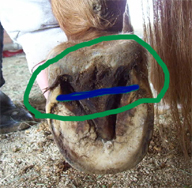 We are not finished yet, but progress with bringing them back, only about 1/2" to go and they are no longer folding over: 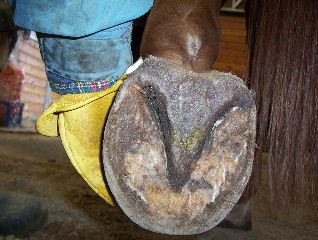 The fat frog I still think is good, but I get that it's too fat and it's taking all the weight. I think getting his heels corrected can only help this, right? Why he's all spread out with a bigger foot could be because he doesn't have shoes on. When we first took his shoes off the front a couple of years ago he splayed out then got more compact. Could this be happening to the back feet as well? Is that a normal occurance? Vicky, that’s a great article! So do I need the farrier to come out and bring back his heels behind? I'm wondering if the fact that the heels aren't folding over any longer indicates that his heels are not too high? Rachelle, I measured him from the coronet band so I could tell when to rasp him, should I be measuring his sole instead? |
| Member: vickiann |
Posted on Thursday, Apr 8, 2010 - 12:17 pm: No, Rachelle.I wish I had photos of Buddy's progress but do not. When I first bought Buddy he had really big feet and when he was Vet checked the Vet said how good they looked and that he was not apt to ever have any foot problems. The Vet was wrong. Buddy was extremely tender-footed for many, many years. The farrier that I first had for eight years seemed to have gradually reduced Buddy's nice big foot. For a while he was shoed as if for navicular after seeing a supposed hoof/leg specialist. He's had his heels raised, been in pads, nothing worked as a real solution. He was lame off and on. Always tender-footed. When ridden he was always trying to get onto softer ground. Walking across cement just being led, he would act like he was going to fall down. When my present farrier first looked at him he said there was way too little foot there to do anything with, so I had to wait several weeks before he could have anything done. As more growth took place, the farrier was able to read his foot, get it balanced and this did include gradual removal of under-run heel. Buddy became and remains sound for the past few years and his way of going is very nice, in complete contrast to how he had ever gone since I first purchased him. He became a whole new horse. I agree totally about what you and Diane are saying about the long toe/under-run heel. And with the toe being correct and the foot in balance I also agree that the heel can fix itself through exercise, given the right conditions. Being laid up for a long time in a stall, especially deep shavings and skipping a trim cycle because of the laminitis, no doubt caused my Perry's heels to under-run. My farrier considered not taking the heels back on Perry recently but this would have necessitated him being walked every day on a hard surface, like my cement drive. Because my horses' have a sandhill environment it makes it harder for them to fix themselves. And horses who stand in stalls most of the day or can't really be ridden or worked much may not have the right conditions to fix themselves. I think that's why in some cases or in some environments, farrier intervention to fix under-run heels may sometimes be necessary. |
| Member: vickiann |
Posted on Thursday, Apr 8, 2010 - 12:19 pm: Aileen,That is a lot of issues for Brave. I hope that you will continue to see steady improvement. You inspire me to get a body worker out again for my horses. |
| Member: scooter |
Posted on Thursday, Apr 8, 2010 - 9:49 pm: Aileen maybe you and I can learn about heels together, I struggle with them more than anything.I hope Rachelle or Angie will help us out here. In the 2 pictures you posted above I don't see a big difference. His wall was higher, but his toe actually looked better tho he was possibly on his sole there? The angles are a little different in these shots. It APPEARS in both pics you are dealing with a bit of a stretched WL also. Anyway I drew lines where the widest part of the frog is, and where the heels end, other than the high wall in the Dec. pic they are about the same, it is good that was addressed. In the recent pic it APPEARS he actually has more toe and his heel is about the same???  OR I may be completely off and hopefully will be corrected  I definitely need help in this area also! I definitely need help in this area also! 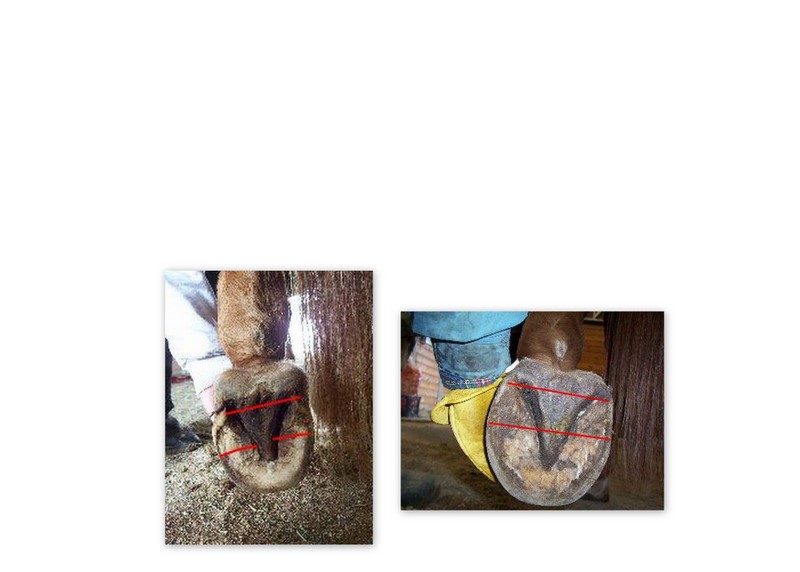
|
| Member: scooter |
Posted on Friday, Apr 9, 2010 - 7:05 am: Aileen I did want to add I know I sound kind of negative, I am well aware it takes a long time to get hooves in order sometimes. My comments are for US to learn and could be way off.When I think of the years Hank suffered because of poor farriers I get rather passionate. I always thought I saw improvement, when his soundness said NO. I blamed it on pathologies ect. which were a small part of the problem. HA people told me for years the farrier was doing a poor job and I did not think so. I am just trying to encourage you to look closely at what is going on with his hooves and educate yourself to make sure they are as optimal as they can get. You asked in your other part why he is always sore after a trim and better right before a trim, that shouts to me the farrier is/was doing something wrong.... now anyway... I couldn't figure it out with Hank either. You said your farrier has been doing Brave for 3 years, who is responsible for the shape his hooves are in now then?? If you think they have improved over 3 years then she is on the right track, it does take about a year to grow a new hoof and some are more difficult than others. Like me you came here and asked questions for a reason... something must bother you about it. Even tho I thought my farrier was doing a good job, something bothered me about his hooves too. Thus the years of threads about Hanks hooves!! You have them in here too. I have become a little too passionate about hooves I guess, and am trying to learn as much as possible from the smart people on this forum and Dr.O. and staring at pictures, reading as much as I can ect. It is overwhelming and hard to understand some of it. I am NOT saying your farrier is to blame, I am saying to educate yourself to makes sure she isn't. As you know Hank has hobbled around here for 5 years, lame and unhappy. I will take responsibility for part of it by letting him get fat, but the farrier definitely didn't help anything in the hoof department.  I wish Brave nothing but to get better and hope I haven't offended you  You have been fighting this as long as I have and I just want you to have a good outcome like I have...(so far anyway)! You have been fighting this as long as I have and I just want you to have a good outcome like I have...(so far anyway)!
|
| Member: sunny66 |
Posted on Friday, Apr 9, 2010 - 11:12 am: Hi Diane Not offended. Sorry I haven't been clear. You already know that I believe something is not right, hence this post. But unless you've been on this site for years, you wouldn't know I usually go above and beyond for my sweet horse. There is no way for you to know that my waking hours spent - not doing chores, sleeping, or working - are spent educating myself trying to figure out what is best to do for my sweet horse. While this site isn't the only one I visit and try to get information from, this is the only one that has a vet for a moderator. I trust that he will chime in if I'm off base. I've read a ton of different protocols, along with an online dialogue with a few barefooters across the US and Canada... most have different ways of doing the same thing, but not all are geared toward dsld, just toward balancing the hoof. Brave is a difficult case as many barefooters and vets I've spoken with have acknowledged. Consults with master farriers are very expensive and would most likely involve shoes. Consults with a qualified barefooter is difficult to come by I'm hoping the the one in Bay Area will be able to visit soon. If there is something specific you feel I should be doing, please let me know Not offended. Sorry I haven't been clear. You already know that I believe something is not right, hence this post. But unless you've been on this site for years, you wouldn't know I usually go above and beyond for my sweet horse. There is no way for you to know that my waking hours spent - not doing chores, sleeping, or working - are spent educating myself trying to figure out what is best to do for my sweet horse. While this site isn't the only one I visit and try to get information from, this is the only one that has a vet for a moderator. I trust that he will chime in if I'm off base. I've read a ton of different protocols, along with an online dialogue with a few barefooters across the US and Canada... most have different ways of doing the same thing, but not all are geared toward dsld, just toward balancing the hoof. Brave is a difficult case as many barefooters and vets I've spoken with have acknowledged. Consults with master farriers are very expensive and would most likely involve shoes. Consults with a qualified barefooter is difficult to come by I'm hoping the the one in Bay Area will be able to visit soon. If there is something specific you feel I should be doing, please let me know  I hope this clarifies that I'm being proactive I hope this clarifies that I'm being proactive  I'm actually getting tired of defending my farrier ... lol ... I've gone through the gamut of farriers. The barefooters up here that I've heard of have lamed horses... not going there. I would rather stay with a farrier that truly cares about my horse and wants to help him then try another who just wants money. I guess I'd rather stay with the devil I know because at least she takes suggestions and applies them. I posted here to get different ideas of things to try because my farrier tried to do a balanced trim and he was sore. Then tried to do much less to see if he was sore, and he was. Your suggestions worked, watch the sole and ensure he's not fully weightbaring on it after a trim. Since it worked, I came back to get some more suggestions  . I'm going with the rasping of the toes and seeing how he feels. The farrier is waiting for a call from me before she does him again. . I'm going with the rasping of the toes and seeing how he feels. The farrier is waiting for a call from me before she does him again. Re: the heels: Look closely at the wall in the picture on the left. It's not higher, it's folded over. That is not good, this I know for a fact. Your line should come down about 1/4 inch. It may be difficult to see that without looking at his hoof in hand. Now look at the hoof on the right. There is no wall folded over, his heels are farther back and he has a much firmer platform to stand on and is much more comfortable. I too hope those with more experience will chime in because I'm certain I'm not explaining it very well. |
| Member: stek |
Posted on Friday, Apr 9, 2010 - 11:14 am: Diane the more the discussion the better in my opinion =) I learn so much from everyone else's input!!This is the way I see the heel pics .. it's a little hard to judge the absolute back of the foot in the pics but I think I'm close... 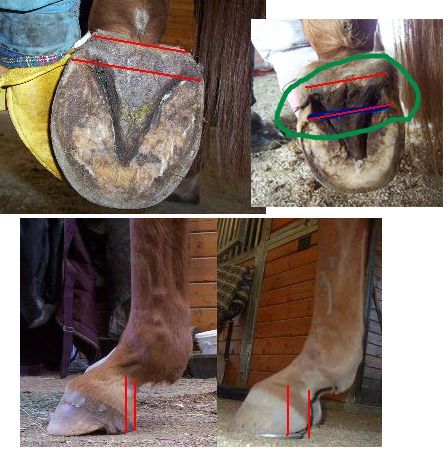
|
| Member: sunny66 |
Posted on Friday, Apr 9, 2010 - 11:31 am: Thank you Shannon! So I was wrong about the back of the foot I thought it was farther back. so not 2 inches, more like 1.5" |
| Member: stek |
Posted on Friday, Apr 9, 2010 - 12:28 pm: I think the back of the foot is easier to judge on the pics with the vertical line. I wasn't sure on the other pics where the sole is shown, so wanted to be more conservative in my guess.We went through a bout of underrun heels with a horse on our farm that was much worse than this, the heels were as far forward but waaaay more crushed. It took about two years to get his heels back under him and strong again. He did wear shoes (and wedge pads which I still don't understand) throughout the process which I think made it take longer. FWIW I think your farrier is doing a good job of bringing his heels back under him. I do worry about why he is sore after a trim - is that still the case, and if so what do you think the reason is? |
| Member: sunny66 |
Posted on Friday, Apr 9, 2010 - 12:48 pm: Thank you Shannon Not sore on his feet, well that I could see. Nowhere near the soreness he had when she trimmed him and left him on his sole at the toe... not at all. Walks on rocks with nary a flinch. He hasn't been in boots since the last time she came out and took a little something off his soles. Even rode him barefoot last night  So, keeping his entire hoof weightbearing, not just one part is very very important 
|
| Member: rtrotter |
Posted on Friday, Apr 9, 2010 - 6:10 pm: Aileen,Here is what bothers me even though I don't know why. I have an aversion to farriers/and blacksmiths, not personally but as an overall trade. They do not seem to understand the word bevel or how to do it properly and why you need to do it on a horse that is trying to go barefoot, and what you wind up with in many cases is a sore horse. I have not had that problem with trimmers that understand the barefoot horse. I just think it a matter of what and how farriers have been taught and it goes against them to even have to deal with the mechanics of barefoot even though it should be easier. That said, your horses foot does look better in the second more current picture, but what is most noticeable to me is that the wall looks flat, not beveled or rolled. Your farrier needs to educate herself on how to do it correctly and then I don't think you will have problems. Remember the bevel needs to be done from the bottom so you can see where your waterline/whiteline is and stay in front of it. Doing it from the top you can't see where to stop and that's where one runs into problems even if you measure the toe length from the coronary band. IMHO that is not going to help because as one bevels, the toe length should get shorter and shorter and so is an inaccurate way to get to where you need to be if you are only taking it back a certain amount to the same spot you were at before. I know its sometimes a difficult concept and I did not pick up on it right away, but once the light bulb goes off as it has with many of us, Braves hoof problems will be a thing of the past. Just keep backing up that toe from the bottom and you will be fine. Can you post some more pictures so we can see the changes from your beveling? Thanks Rachelle |
| Member: sunny66 |
Posted on Friday, Apr 9, 2010 - 6:42 pm: Thank you Rachelle, remember, I don't know how to bevel the camera I’m using was loaned to me because mine broke and she needed it. I’m not certain when I’ll be able to get it back. I’m buying it from her though so it shouldn’t be too long. the camera I’m using was loaned to me because mine broke and she needed it. I’m not certain when I’ll be able to get it back. I’m buying it from her though so it shouldn’t be too long. When you say the measuring and rasping to keep it the same doesn’t make sense. I understand now what you’re saying. I was thinking that I could use it as a guide so his hind toes stay the same, while his heels move back. I’ll need your help because I will be quite conservative until I get a handle on this. I plan on rasping tomorrow. |
| Member: stek |
Posted on Friday, Apr 9, 2010 - 6:53 pm: Rachelle I think your description of how to keep after Brave's feet is right on. The pic below is what made me think the farrier put a decent bevel on this trim. Not the most aggressive, but looks to me like it's beveled from the bottom and made an attempt to give him a decent breakover.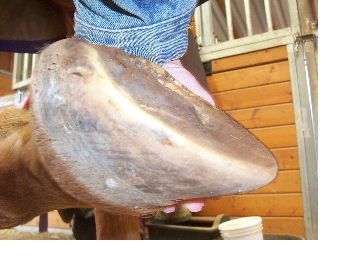 It's funny how much our own experiences color our perceptions. For me, I have worked with many top notch farriers over the years and honestly never had a problem with lame horses after shoes, trims, or corrective trims. When I first started working with barefoot trimmers, the first four I encountered severely lamed horses in their care and said it was a normal process. Not horses who were just going barefoot for the first time mind you but horses who had been barefoot for years and who were routinely very sore for a week or so after every trim. So my own prejudice is probably for farriers and against barefoot trimmers. Good to at least realize our prejudices in an attempt to overcome them... |
| Member: rtrotter |
Posted on Friday, Apr 9, 2010 - 8:45 pm: Shannon, I too have worked with some excellent farriers, when I thought that it was shoes I needed. Then I learned you can't shoe a lame horse sound and you really can't fix their feet with shoes. The shoes create their own set of problems. You might be able to mask a problem for a certain length of time, but you will never truly fix their feet.Most people give up going barefoot because it means they may lose the use of their horse for a time and are not willing to wait, so back on go the shoes. In my opinion, this just slows down the process. I will admit it is very frustrating at times, but I find if I weigh the pros and cons of shoes versus barefoot, barefoot wins hands down. At least in my book. I'm spoiled after my first few attempts to try and train my farriers to trim properly and not getting them to do what I want, I found my current trimmer on the first try and I have been using him ever since. I really think its the farriers mindset more than anything else and they tend to want to stay in the shoe frame more than the barefoot frame. As one of the best farriers on the East coast once told me" I wish all horses could remain barefoot it would make my job easier", but then he added "but I wouldn't make any money doing it". I am not saying all farriers are like this but I think the money makes it more lucrative to shoe then trim, not that shoeing benefits the horse Just my thoughts Rachelle |
| Member: lilo |
Posted on Saturday, Apr 10, 2010 - 9:49 am: My first farrier who trimmed my horses for years was a darn good farrier - could make shoes from scratch if needed for a particular problem. But, when I decided to let the horses go barefoot he was most supportive. He trimmed them, and they were never sore. My husband used to be surprised how little he took off at times (but, you don't pay for the amount taken off, you pay for a balanced foot and a sound horse).I switched to my neighbor mostly because her prices were lower, and I was retired and watching every penny. The first farrier still works for my friend who has 8 horses, only one in shoes. My neighbor is also a certified farrier, but does not mind maintaining a barefoot horse. Guess, as usual, I am just lucky!!! It would make me very nervous if a trimmer said it was normal for a horse to be tender footed after a trim. Good luck to all, Lilo |
| Member: rtrotter |
Posted on Saturday, Apr 10, 2010 - 10:30 am: Lilo,Your husband is more the norm than you may think and unless one understands whats going on like you do, they tend to get a bit put out when the trimmer comes and removes very little and charges full price. "My husband used to be surprised how little he took off at times (but, you don't pay for the amount taken off, you pay for a balanced foot and a sound horse)". To me this is a good sign, it means the hoof growth and amount of wear is just right for that particular horse. It then tells me how often I have to have him come out to keep the foot balanced and I can see for myself if there is anything else I need to do to keep their feet in the condition they need to be in for the discipline I am in(racing). In a perfect world, my horses would completely self trim themselves where neither I or my trimmer would have to touch them, but its always better to have someone other than oneself take a look to see if any thing is amiss. So I tend to use my trimmer's visits as a reality check and find the money spent is well worth it. Rachelle |
| Member: stek |
Posted on Saturday, Apr 10, 2010 - 2:10 pm: The farriers I use are happy to do either barefoot or shoes, they charge roughly half for a trim that they do for shoes and trims take about 20-30 minutes rather than an hour and a half plus to shoe. I am always surprised that more farriers aren't proponents of barefoot for the profit margin alone .. no materials aside from a good rasp and hoof knife, no forge to fire up, and a heck of a lot less effort involved (comparatively). Of course you couldn't pay me enough to spend all day bent over under people's horses, what a brutal job!I guess like you say Rachelle it depends on the mindset of both the person working on the horse and the owner who wants more than anything a sound usable horse. All our horses are barefoot, and we are lucky enough to have a pretty good variety of terrain so they get conditioned without us having to do much. I do have one mare who I have shod for convenience if I will be riding her hard over very rough ground. I look at shoes the same as I do boots, just tools to protect from worst case conditions. I have seen some applications of shoes for specific therapeutic reasons but those cases are the minority. |
| Member: rtrotter |
Posted on Saturday, Apr 10, 2010 - 2:42 pm: Shannon,My trimmer costs me $60. If I was to shoe the way I want with all glue ons it would cost me almost $400 per horse every three weeks. Rachelle |
| Member: stek |
Posted on Sunday, Apr 11, 2010 - 12:20 pm: Yikes!! My farriers who have 20+ years experience and keep up with continuing ed charge $40 for a trim and $100 for a full set of shoes. Some of the barefoot trimmers around here who have only been in business for a year or two charge $70-$80 per trim. So much depends on where you are and who you have available... |
| Member: rtrotter |
Posted on Sunday, Apr 11, 2010 - 3:51 pm: Shannon,If I was to shoe with 4 metal shoes it would cost between $80-120,add pads its another $40 but I don't want to put nailed on shoes on my horses, so it costs more to do the glue ons. Rachelle |
| Member: stek |
Posted on Monday, Apr 12, 2010 - 10:55 am: That glue must be made of gold =) I've always wondered about the cost of the glue-ons, now I know for sure they are out of my price range! No wonder you are working so hard to come up with a good solution for your horses. If you do come up with something cost effective the market is probably ripe for it. |
| Member: rtrotter |
Posted on Monday, Apr 12, 2010 - 7:57 pm: It's not the glue although that can get pretty expensive, it's the foot prep to get the glue to hold and then again half the time it doesn't hold well at all. And yes that is why I am trying to find a way to deal with my horses' feet without having to resort to nails or glue.Rachelle |
| Member: sunny66 |
Posted on Sunday, Apr 18, 2010 - 7:30 pm: Hi All, well he keeps getting better, so far anyway. He overdid it a bit a few days ago, rodeoing, trotting, cantering... on no pain meds.I am still wrapping all four legs at night (Dr. O, is this ok? I've had someone tell me continuous wrapping can cause weakening of the tendons, even though it's just at night, nothing on during the day). I rasped all four feet today, sorry, no pictures. I haven't gotten the camera back yet. I will ask for it though. Anyway, after the rodeo he was very sore. I did my due diligence per the reiki and have been working on nerves for him. I took him out on the lunge without working on him and watched him walk. He looked good, not great, but no worse. So I stopped him and worked on the nerves, walked him again and he looked better - didn't go as far down, just a bit better than 45 degrees. I called my vet and told him to be ready to "poo poo" this since this is not scientific at all. Told him that working on his nerves helps a lot and am I missing a test or something that could help me help him more. He told me that if it helps, keep doing it; but while he wouldn't "poo poo" the idea he didn't give much credence - nothing proven via reiki. He said I'm doing the right things, went scientific first and when that failed, sotospeak, looked elsewhere. Dr. O, I've read your nerve articles and he really doesn't have any of those symptoms. Oh, and still not on pain meds and doing great. Riding him 5-10 minutes a day - depending on what he can handle, working up to more. I'm watching his paddock closely for any signs of digging (which he used to do after getting up) and haven't seen any divots yet. Knocking on wood furiously. but I did see that he is again standing by the barn and getting his heels up. I can tell by his hoofprints near the barn. Would this warrant pain meds? Thank you all very much for helping me help my boy! |
| Member: frances |
Posted on Monday, Apr 19, 2010 - 3:20 am: VERY good news Aileen! You deserve it for all your dedication. |
| Member: scooter |
Posted on Monday, Apr 19, 2010 - 4:53 pm: 
|
| Member: lilo |
Posted on Monday, Apr 19, 2010 - 8:53 pm: Good news! Hope that he will continue to improve.Lilo |
| Member: sunny66 |
Posted on Tuesday, Apr 20, 2010 - 10:58 am: Thank you all Just to be clear, we're not out of the woods yet, not by a longshot. He has improved before only to backslide. He did dig a bit yesterday, so he's on pain meds; however, we have a storm in right now. I will be curious to see if he doesn't need as many pain meds when the weather cooperates for a longer period of time. Just to be clear, we're not out of the woods yet, not by a longshot. He has improved before only to backslide. He did dig a bit yesterday, so he's on pain meds; however, we have a storm in right now. I will be curious to see if he doesn't need as many pain meds when the weather cooperates for a longer period of time. His attitude is still just lovely, moving well (heel first on all four feet!) and comfortably, pulling over the manure bucket, etc ... lol ... I will probably give him another pain med tonight then see what happens. It's supposed to DrOp about 20 degrees tonight - from 50 degrees this morning to 36 degrees tonight. Hey LL, I forgot to phtu phtu phtu! |
| Member: frances |
Posted on Tuesday, Apr 20, 2010 - 2:43 pm: Uh-oh ...but you remembered to phtu phtu at the end, so it SHOULD be ok! ...but you remembered to phtu phtu at the end, so it SHOULD be ok! 
|
| Member: vickiann |
Posted on Tuesday, Apr 20, 2010 - 2:52 pm: Glad to hear of improvement and hope that it continues. |
| Member: sunny66 |
Posted on Saturday, May 1, 2010 - 1:06 pm: Update: Finally got the camera back. He looks better in person, these pictures are making me cringe, what the heck is up with the left hind? Bars?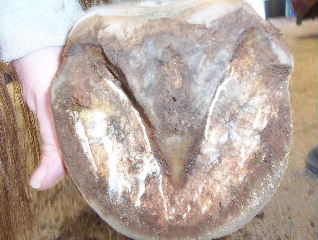 His wrinkles aren't as wrinkly: 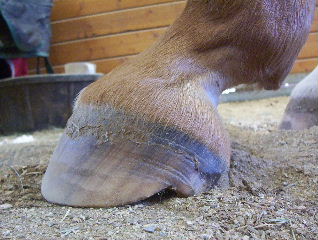 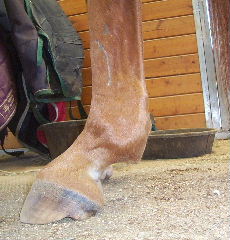 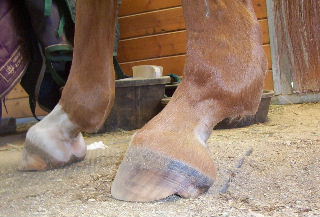 The right hind pictures didn't come out for some reason, so here's the fronts: Left front: 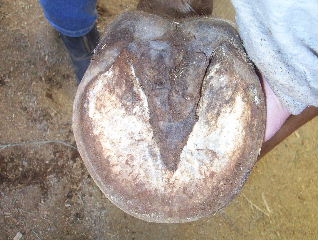 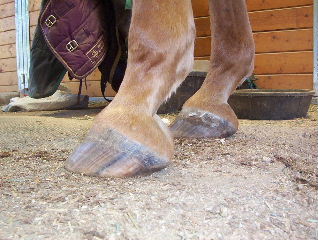 Right front: 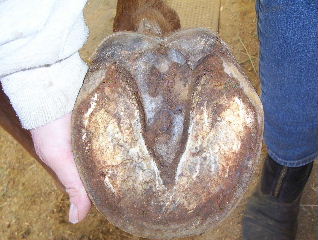 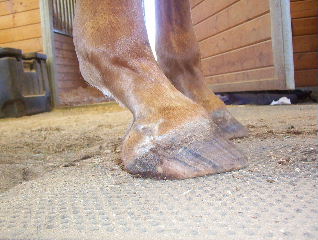 I've been bringing his toes back once a week.It's been wet, so I was afraid I was taking too much so I didn't do it as often, but I think I was wrong. Farrier came out yesterday and just took his heels back, cleaned out his thrush and beveled his quarters. She was pleased I didn't screw him up too badly. lol. She wants to see how he wants to grow, but I'm still to rasp him to keep the toes in check. So, is he worse off? I think so, a bit. Not sure if I think so because he's not on pain meds so his fetlocks are filling up - it's either that or he's out again behind, which is entirely possible by the way he's standing with the right hind. I'm thinking to put him back on them every other day to keep the puffiness in check, thoughts? |
| Member: scooter |
Posted on Sunday, May 2, 2010 - 12:51 pm: Hi Aileen it is really hard to comment on your pics, if you can take some straight on, and from the sides for the sole pic (looking down at hoof) and clean the hoof well....and start another part..this one is LONG loadingLooks like his fetlocks have improved some |
| Member: sunny66 |
Posted on Sunday, May 2, 2010 - 5:08 pm: Thanks Diane I was told it was most likely bar so I worked on him a bit today, I'll take some more pictures (and try to get them right!) then start a new thread. I was told it was most likely bar so I worked on him a bit today, I'll take some more pictures (and try to get them right!) then start a new thread.
|
| Member: vickiann |
Posted on Sunday, May 2, 2010 - 8:24 pm: I thought things looked a bit better, Aileen.One of my daughter's jumping mares was here a year ago for rehabilitation and she was literally walking on her bars that protruded well downward beyond the sole. It was bizarre but my natural farrier had warned me that such a thing might happen. She self-trimmed those bars away quickly, even on my sandhill environment. My farrier doesn't mess with the bars though I know that many folks do. |
is The Horseman's Advisor
Helping Thousands of Equestrians, Farriers, and Veterinarians Every Day
All rights reserved, © 1997 -
